Jean Gabriel Augustin Chevallier, 1778 - 1848
"l’Ingénieur Chevallier"
Alexandre Victor Ducray-Chevallier, 1810 - 1879
Marie Louise Mélanie Chevallier, 1815 - 1897
"Maison de l’Ingénieur Chevallier"
René Gabriel Avizard, 1853 - after 1908
Charles Xavier Avizard, 1855 - after 1912
"Maison de l’Ingénieur Chevallier"
by Brian Stevenson
last updated January, 2022
Among the most highly acclaimed Parisian optical businesses were two firms with very similar names, Chevallier and Chevalier. The two families were not related, but the similarities in their names frequently leads to confusion, and instruments produced by one firm are often attributed to the other. Even during the nineteenth century, some writers misspelled their names, or mixed up relationships.
Jean Gabriel Augustin Chevallier established his shop at 1 Quai de l’Horloge, Paris, in 1796. A skilled workman, he adopted the honorific “l’Ingénieur” (the Engineer), and often signed his microscopes, telescopes, and other instruments as “l’Ingénieur Chevallier”. He received numerous honors from the Republic, Emperor Napoleon, and subsequent royalty, including being made a knight (“Chevalier”) in la Légion-d'Honneur. That honor can create further confusion, as he occasionally described himself as both Chevallier and “le Chevalier”.
J.G.A. Chevallier sold his business in 1842 to his son-in-law, Alexandre Victor Ducray, and daughter, Marie Louise Melanie Chevallier. In 1848, they and their children legally adopted the surname “Ducray-Chevallier”.
Around 1842, the business was moved a short distance to 15 Rue de Pont-Neuf. The elder Chevallier remained associated with the firm, in an advisory role. After J.G.A. Chevallier’s death, the firm became “Maison de l’Ingénieur Chevallier” (House of the Engineer Chevallier). That name was retained after Alexandre Ducray-Chevallier’s death and the sale of the business by Marie Louise to Charles and René Avizard, and persisted well into the twentieth century.
J.G.A. Chevallier also has a son, Pierre Marcel Augustin Chevallier (1797-1841), who started an independent optical business in about 1835, at 1 Rue de la Bourse, Paris. P.M.A. Chevallier evidently went by the name Augustin, and his microscopes and other instruments are often signed “A. Chevallier”. After his death, P.M.A. Chevallier’s business was purchased by Pierre Louis Amédée Queslin (1819-1883). He and his successors called their shop “Maison de Chevallier”, described as “the sole successor to Chevallier”. Microscopes by Queslin are known that are signed “Maison Chevallier L’Ingr Queslin”. While all of those statements are accurate, they were undoubtedly intended to confuse customers.
The other family of prominent Paris opticians spelled their surname with a single “L”, Chevalier. They were the father-son-grandson trio of Vincent Chevalier (1770-1841), Charles Chevalier 1804-1859), and Arthur Chevalier (1830-1874). Vincent Chevalier’s shop was located near that of J.G.A. Chevallier, at 52 Quai de l’Horloge (later number 69 of the same street), and Charles set up at Rue de Valois and the gallery of the Palais Royal. For a while, Charles Chevalier advertised himself as “Chevalier l’Ingénieur”, until an 1857 lawsuit from Ducray-Chevallier forced him to cease. In addition, the business name “Arthur Chevalier” was retained for several decades after his death, and the company had been acquired by unrelated owners (ironically, the same Charles and René Avizard who bought Maison de Chevallier).
Collectors and historians need to pay careful attention to spellings, addresses, and arrangements of words on instruments, in order to know who produced or sold that apparatus.
A brief summary of important dates in the Chevallier optical businesses:
1796: J.G.A. Chevallier opened his business at 1 Quai de l’Horloge.
1842: Alexandre Victor Ducray and Marie Louise Mélanie Chevallier purchased the business of J.G.A. Chevallier. The father remained in an advisory role.
1842: The Chevallier business moved to 15 Place du Pont-Neuf.
1848: J.G.A. Chevallier died, and the business adopted the name “Maison de l’Ingénieur Chevallier”. Ducray and his family legally changed their surnames to Ducray-Chevallier.
1879: A.V. Ducray-Chevallier died.
1883: The business was purchased by Charles and René Avizard. The business retained the name of “Maison de l’Ingénieur Chevallier”, and it appears to have been managed by André Norbert Nanta. The Avizards maintained their original business at a different location.
1900: The Avizards moved the shop to 21 Rue Royale, and merged their businesses under the name “Maison de l’Ingénieur Chevallier, Avizard Frères, successeurs”. The shop moved to 27 Avenue de l’Opéra between 1914 and 1921.
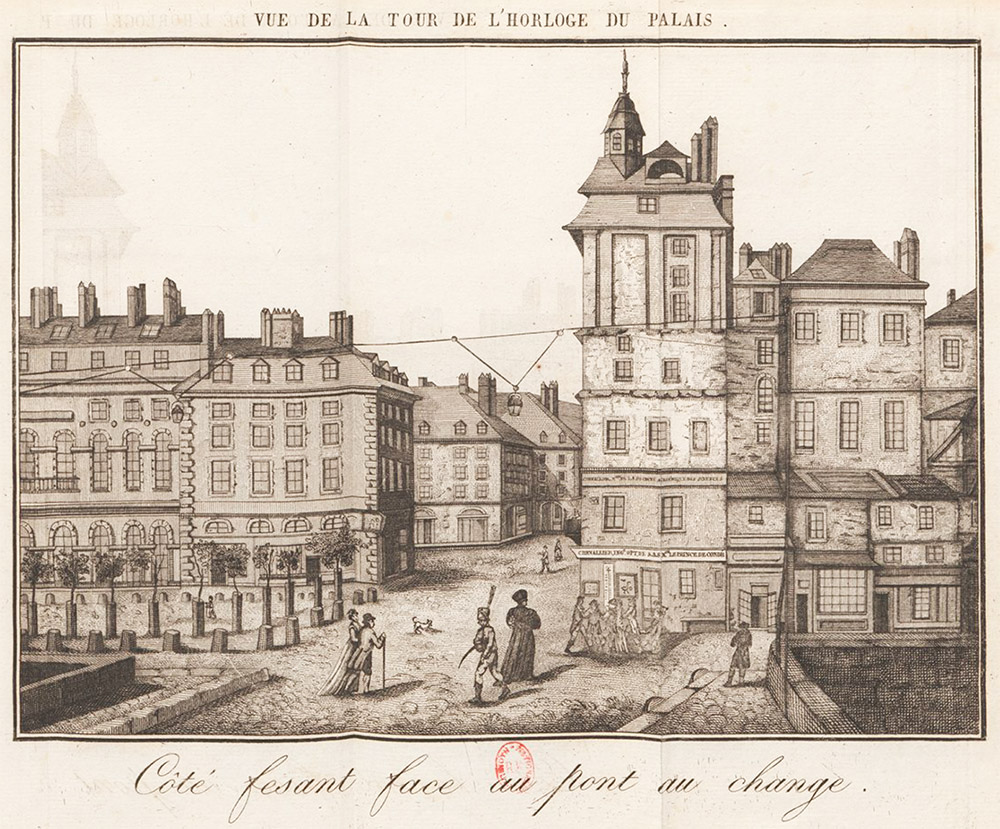
Figure 1.
1815 view of J.G.A. Chevallier’s shop at 1 Place de l’Horloge (also known as la Tour de l’Horloge, the Clock Tower), looking south from the Pont au Change bridge across the River Seine. Chevallier’s shop is the tall building in the right-center. Place de l’Horloge extends to the right in this picture. The Marché aux Fleurs (Flower Market), an open space with small trees, is to the left. The crowd of people in front of Chevallier’s shop are looking at the large thermometer outside. Chevallier established an observatory and weather station at the top of his tower, from which he recorded and reported each day’s atmospheric conditions. Image adapted from Chevallier’s 1815 edition of “Le Conservateur de la Vue”.

Figure 2.
Another 1815 view of J.G.A. Chevallier’s shop, viewed from the Marché aux Fleurs (Flower Market).

Figure 3.
Title pages and dedication of J.G.A. Chevallier’s 1810 “Le Conservateur de la Vue”. Chevallier signed the left page. The book was dedicated to his patron, the King of Westphalia.
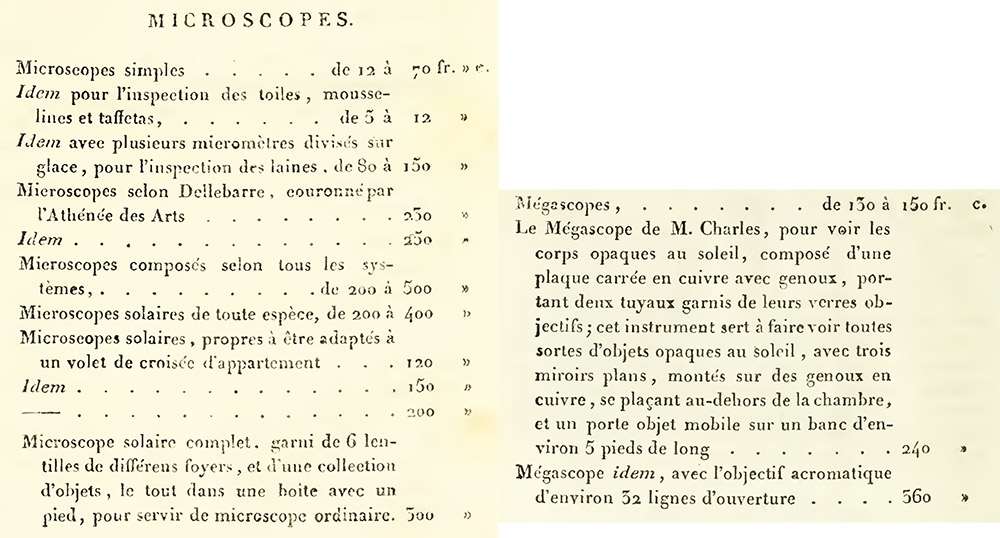
Figure 4.
J.G.A. Chevallier’s 1810 edition of “Le Conservateur de la Vue”, and subsequent editions, included a catalogue of his various scientific and engineering products. In 1810, he sold several types of microscopes, including simple microscopes, compound microscopes in the style of Dellebarre, and solar microscopes. Engravings of his microscopes, from this and later editions, are shown below.
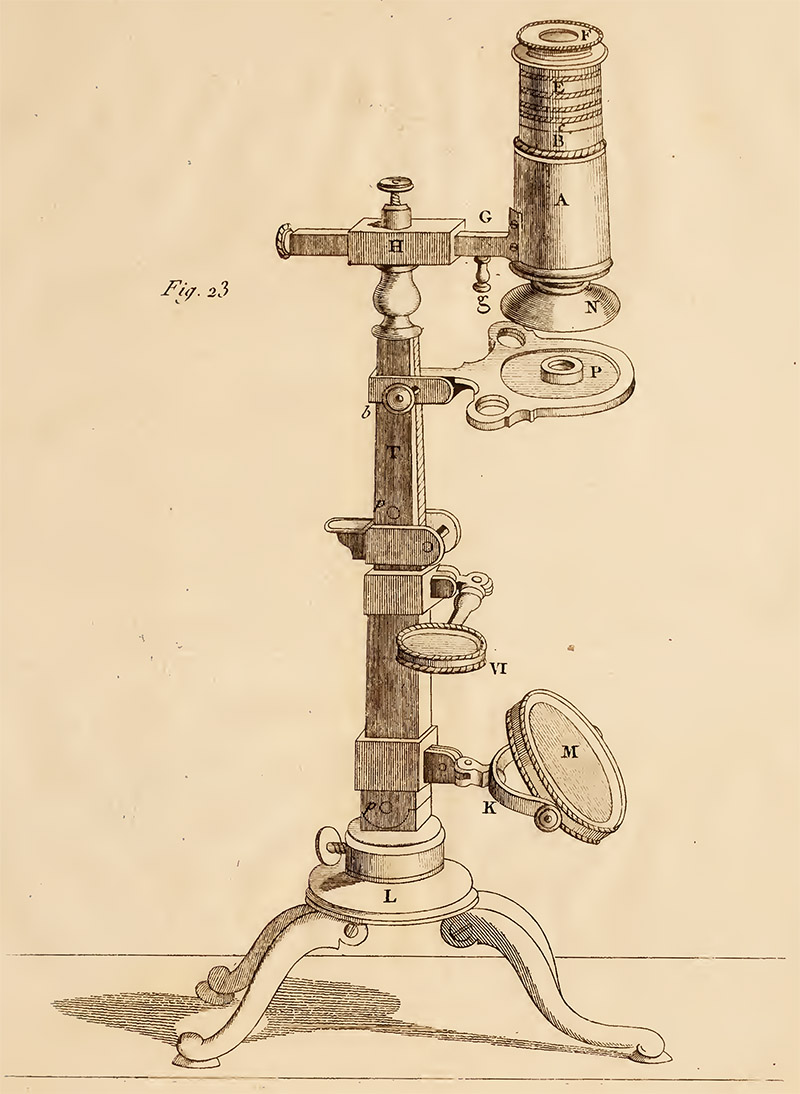
Figure 5A.
Engraving of a Dellebarre-type microscope, from J.G.A. Chevallier’s 1810 edition of “Le Conservateur de la Vue”. The book included a chapter on this model of microscope. In 1807, Chevallier published a book, “Instruction sur le Microscope, Construit d’apres les Principes de feu Dellebarre, par J.G.A. Chevallier, Inénieur-Opticien”.

Figure 5B.
A Dellebarre-type microscope, signed "Chevallier Ingr, de S.A.R. Monsieur, vis a vis le Marché aux Fleurs" ("S.A.R. Monsieur" indicates that he was a Fellow of the Societé Académique Royale) . Adapted by permission from https://histoiredumicroscope.com/chevallier-jean-gabriel-august-inv-407/.
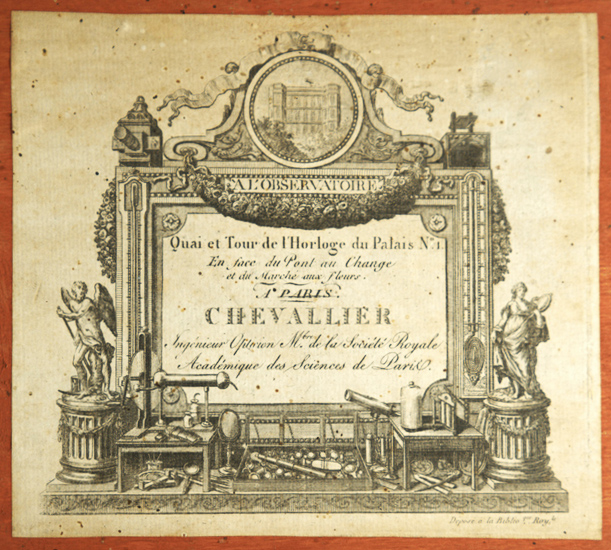
Figure 5C.
J.G.A. Chevallier trade label with his Marché aux Fleurs address, which is pasted inside the case of the Dellebarre-type microscope shown in Figure 5B. Adapted by permission from https://histoiredumicroscope.com/chevallier-jean-gabriel-august-inv-407/.

Figure 6.
Engraving of a solar microscope, from J.G.A. Chevallier’s 1810 edition of “Le Conservateur de la Vue”. The book included a chapter on the use of this type of microscope.

Figure 7.
Engraving of a simple, case-mounted microscope, from J.G.A. Chevallier’s 1815 edition of “Le Conservateur de la Vue”. This style was popular throughout the world for many decades.

Figure 8A.
A “Selligue”-pattern microscope, engraved “L’Ing Chevallier Opticien du Roi et des Princes vis-à-vis le Marché aux Fleurs No1 à Paris”. Selligue developed this model and its lens system in collaboration with Victor and Charles Chevalier. A lengthy description of the optical system in 1824 mentioned only Selligue’s contributions, which caused the Chevaliers to cease working with Selligue. J.G.A. took up the pattern, as was described by Palaprat in 1827. That information, and the address on the microscope, dates its production to between ca. 1825 and 1842, when Chevallier moved to 15 Rue de Pont-Neuf. Images adapted by permission from Alexandre Piffault.
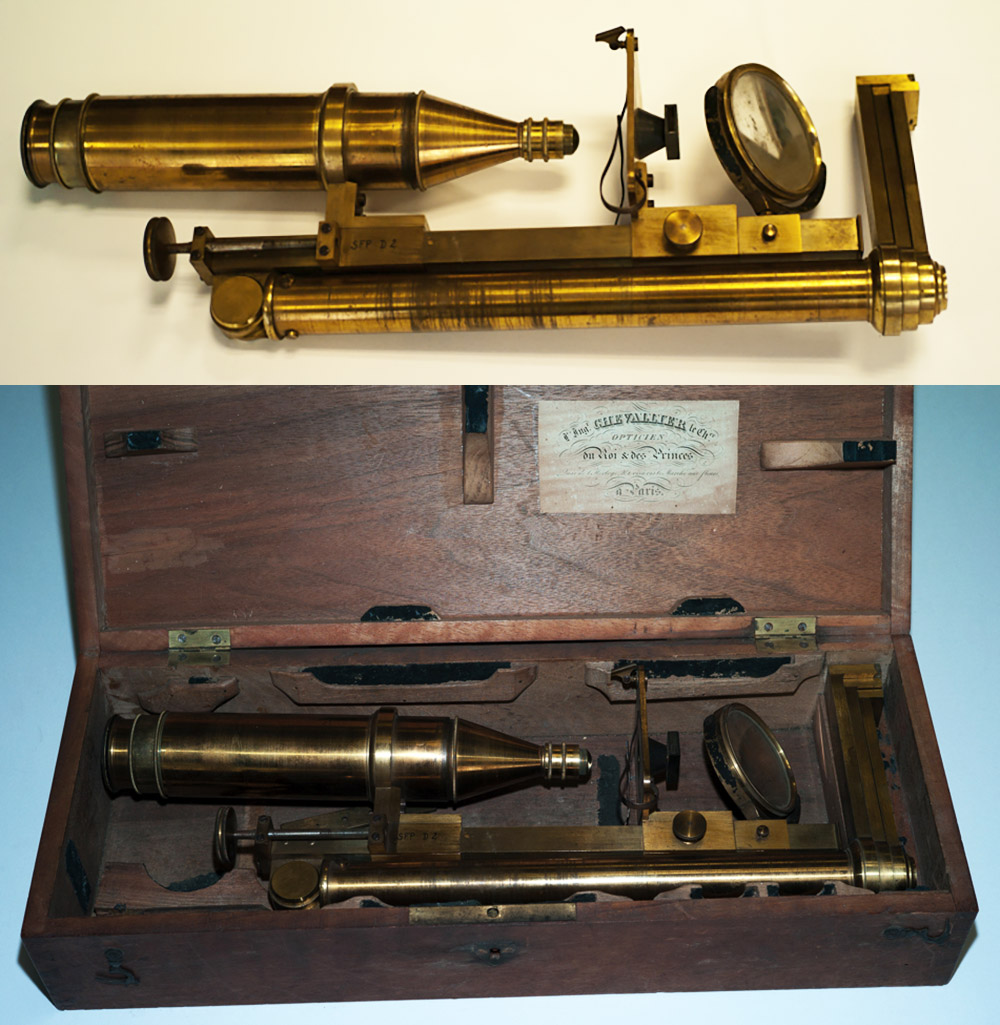
Figure 8B.
Another “Selligue”-type microscope. The label pasted in the case reads “L’Ing Chevallier Opticien du Roi et des Princes vis-à-vis le Marché aux Fleurs No1 à Paris”. As above, it dates between ca. 1825 and 1842. Adapted for nonprofit, educational purposes from http://www.niepce-daguerre.com/Vincent_et_C_Chevalier.html.
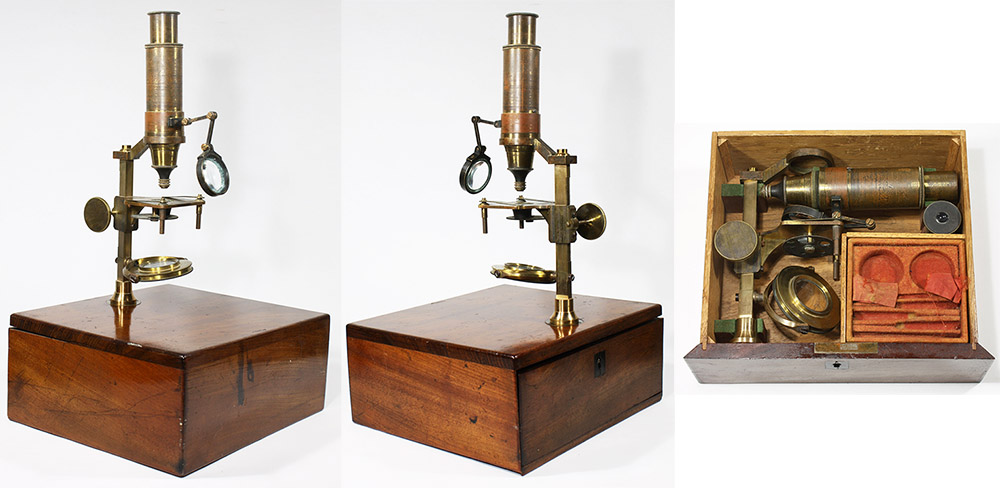
Figure 9A.
Circa 1830s compound microscope, signed "L’Ingr Chevallier, Opticien du Roi, Tour de l’horloge du Palais a Paris". The components pack into a drawer in the wooden case. Adapted for nonprofit, educational purposes.

Figure 9B.
Circa 1835 drum microscope, signed "L’Ingr Chevallier, Opticien du Roi, Vis à vis le Marché aux Fleurs, a Paris". It is identical to microscopes that were manufactured by Oberhaeuser and Trécourt during the mid-1830s, and was most likely made by that business. The microscope's base, and its storage cabinet, are marked with the number "31", possibly Oberhaeuser and Trécourt's serial number. Adapted for nonprofit, educational purposes.
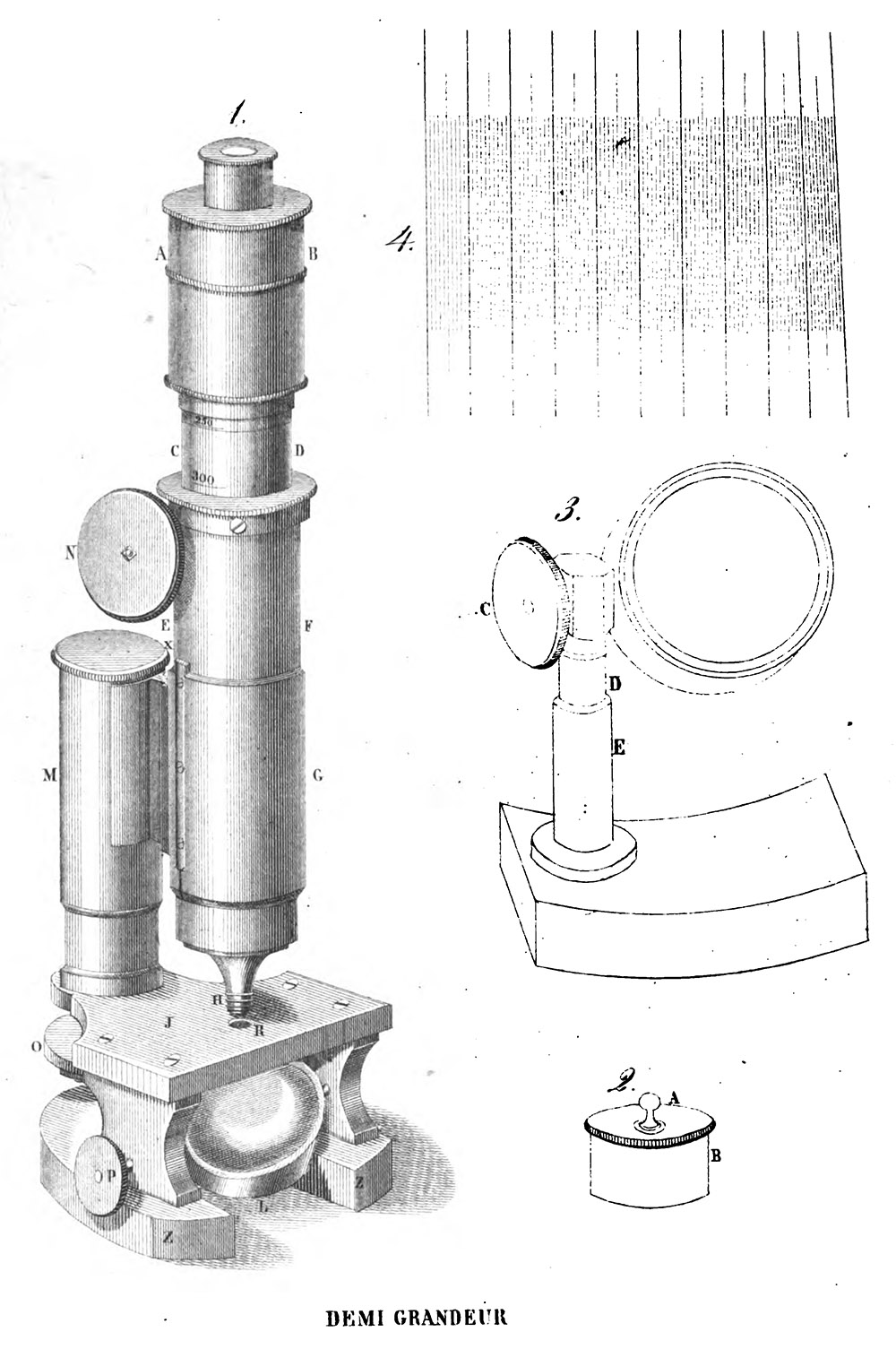
Figure 10.
“Le Microscope Pancratique”, ca. 1841, designed by Alexandre Fischer and produced by J.G.A. Chevallier. Adapted from Fischer’s book of the same name.
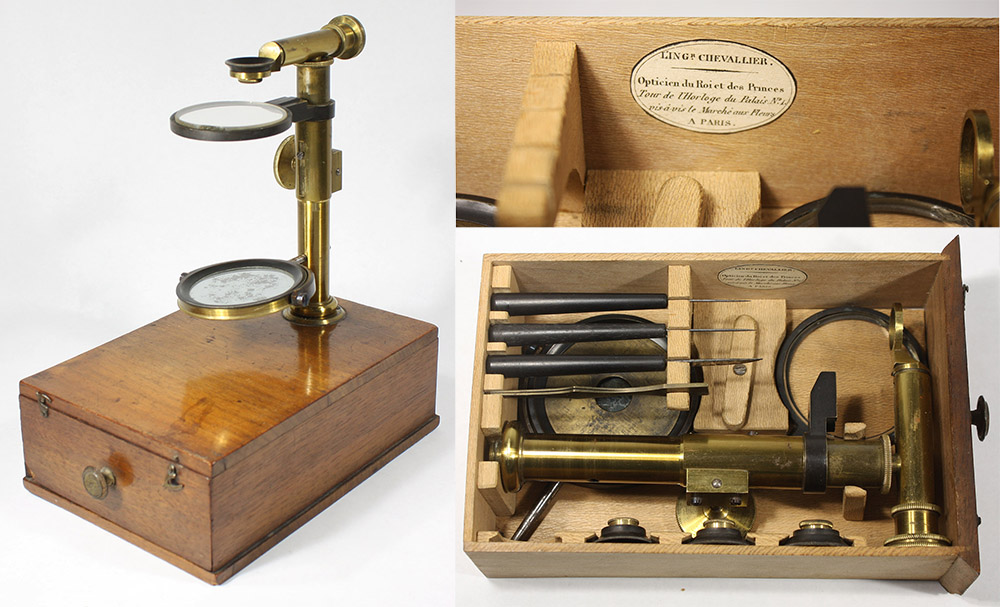
Figure 11.
Raspail-type simple microscope, with trade label “L’Ing Chevallier, Opticien du Roi et des Princes, Tour de l’Horloge du Palais No. 1, Vis-à-vis le Marché aux Fleurs, a Paris”. The instrument was probably manufactured by Louis Deleuil (1795-1862), who is famous for his Raspail-type microscopes. Adapted for nonprofit, educational purposes.

Figure 12.
Collapsible monocular opera glass / peep scope, signed “L’Ing Chevallier, Breveté du Roi, Vis-à-vis le Marché aux Fleurs à Paris”. Adapted for nonprofit, educational purposes.

Figure 13.
A portrait of J.G.A. Chevallier, from "Les Artisans Illustres", by Edouard Foucaud, 1841.
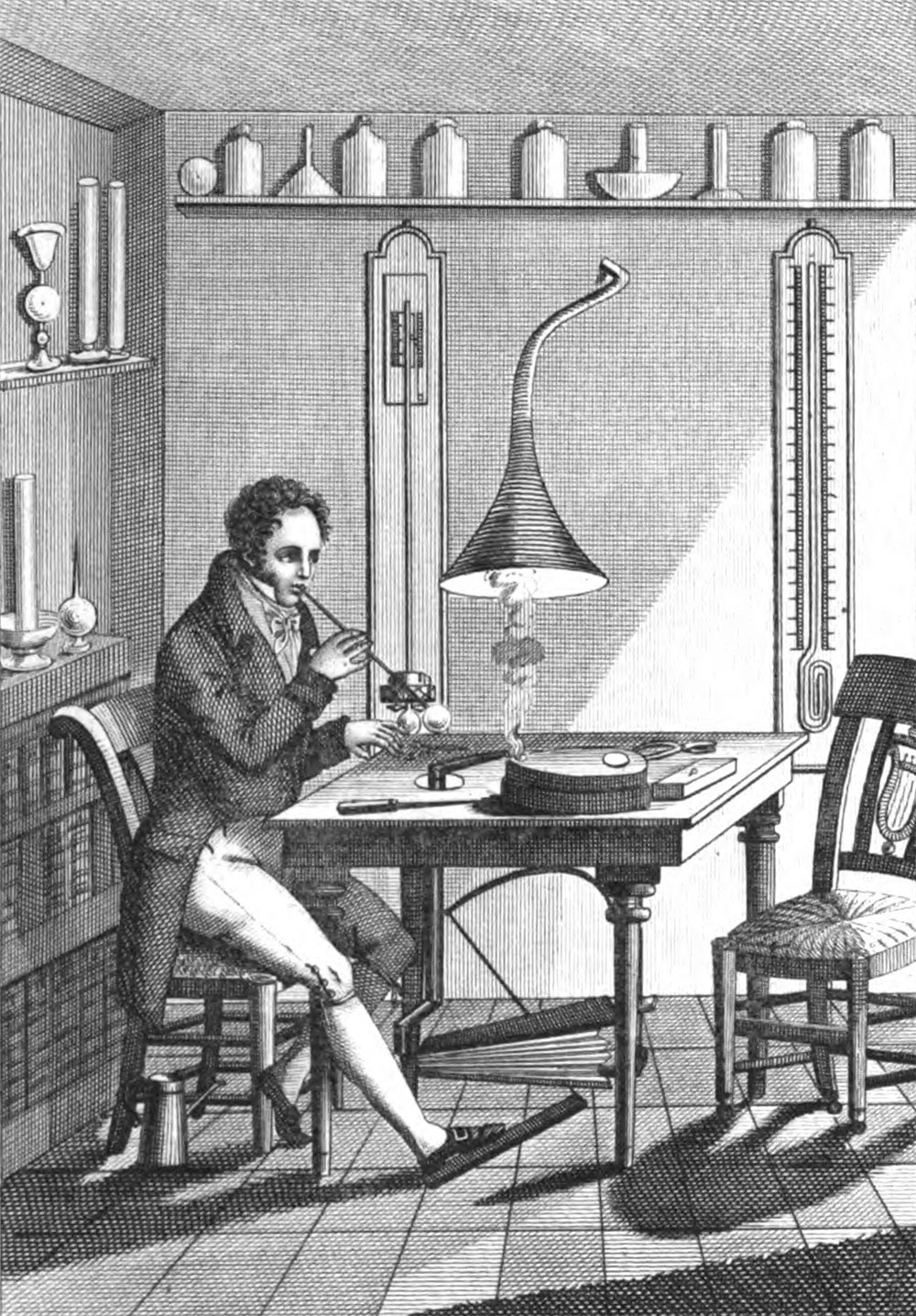
Figure 14.
Possibly a picture of J.G.A. Chevallier, blowing glass, from his 1819 “Essai sur l’Art de l’Ingénieur en Instrumens de Physique Expérimentale en Verre”. The book describes and illustrates numerous Chevallier glass products, such as thermometers and barometers (examples of which are on the wall behind the glassblower). Chevallier would have been 41 years old when the book was published. Considering the detail, the picture would appear to be of a specific person, and who better than the author and owner of the shop?
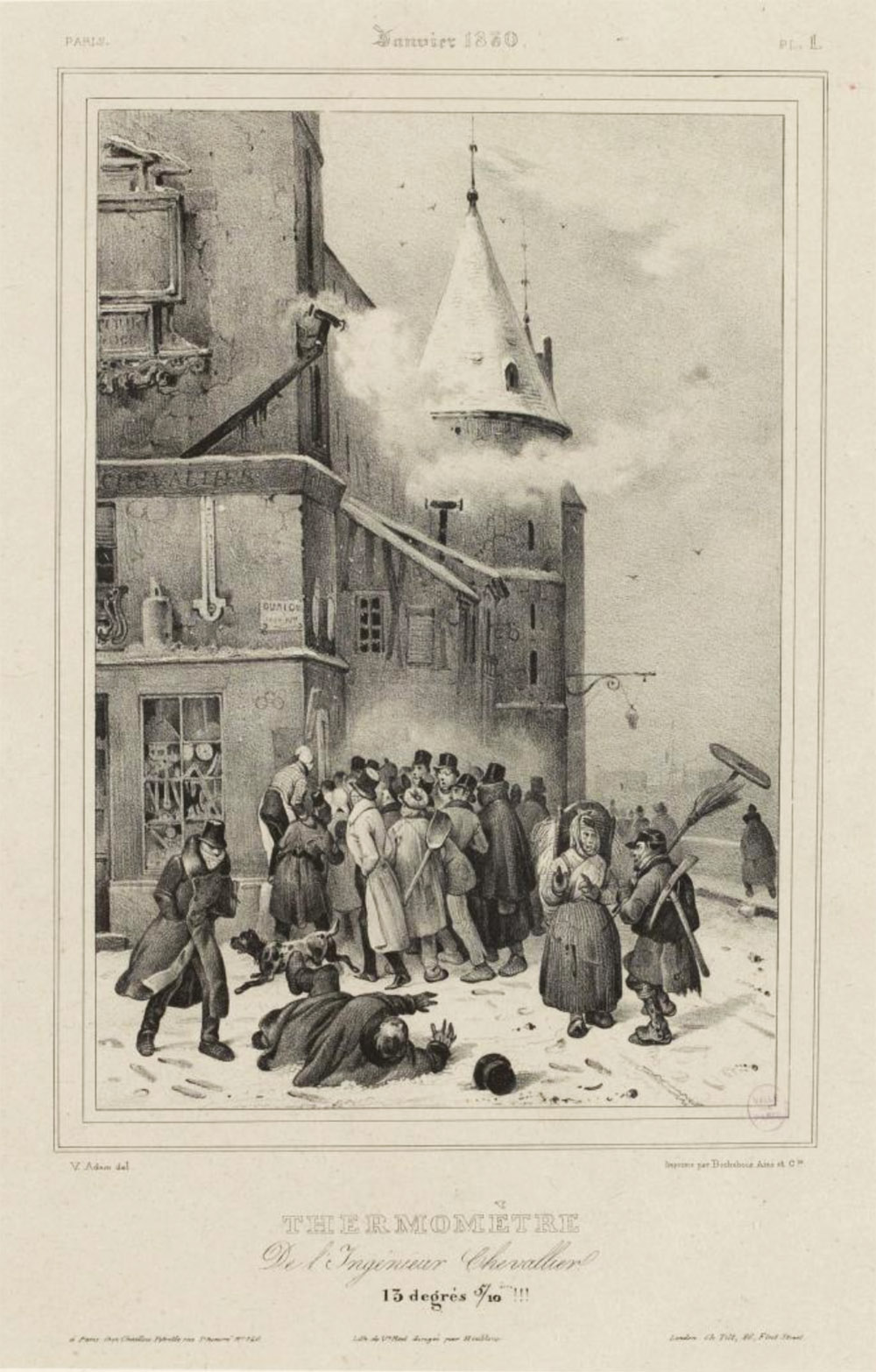
Figure 15.
An engraving of Chevallier’s shop in January, 1830, with people gathered around his giant thermometer to see the extent of the cold air temperature. Adapted for nonprofit, educational purposes from http://parismuseescollections.paris.fr.
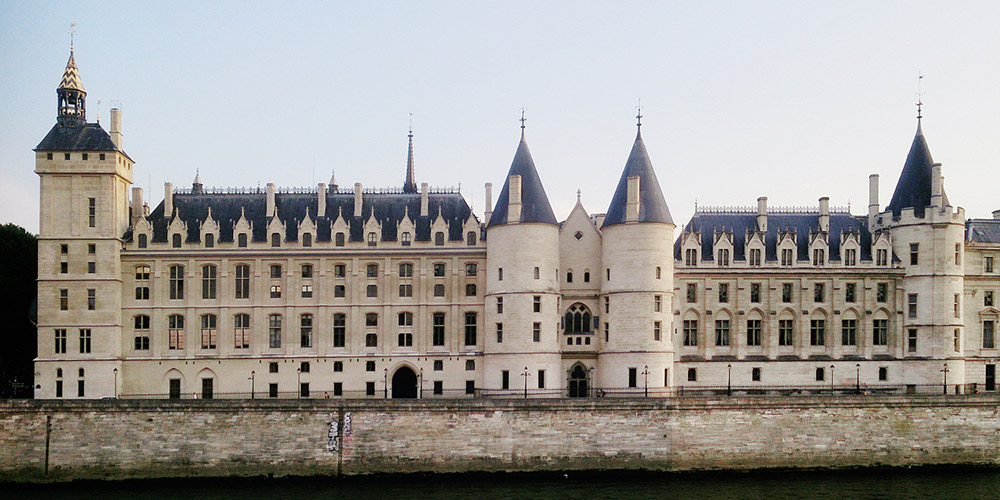
Figure 16.
A recent view of the Palais de la Cité. The tower at the left was Chevallier’s shop and residence from 1796 until 1842. Adapted for educational, nonprofit purposes from https://en.wikipedia.org/wiki/Palais_de_la_Cité .
Jean Gabriel Augustin Chevallier was born in Mantes, on the outskirts of Paris, on September 13, 1778. His father was a notary and court bailiff. Most importantly for Chevallier’s future, his maternal grandfather was François Trochon, a noted optician in Paris. Trochon had established a shop in the clock tower at 1 Place du l’Horloge in 1740, which Chevallier later inherited. That provided Chevallier and his successors with a claim to be one of the oldest optical businesses in Paris. Chevallier studied under Trochon and an uncle, as well as Parisian opticians, astronomers, scientists, mathematicians, and engineers such as Noel-Jean Paymal Lerebours (1761-1840) Joseph Jérôme Lefrançois de Lalande (1732-1807), and Georges Cuvier (1769-1832).
Chevallier took over the family business in 1796. His earliest catalogues indicate production (or sale, at least) of a wide variety of optical, scientific, and engineering apparatus. In addition to his scientific and political connections, Chevallier used a number of techniques to expand his customer base. Early on, he mounted a very large thermometer on the wall outside his shop, which drew in crowds, especially on very cold or hot days. Chevallier also recorded climate conditions from an observatory in the top of his building, and reported daily observations. He also produced a number of books that helped to spread his name, such as his 1805 book on sundials, Instruction sur l'Usage des Cadrans Solaires Horizontaux et Universels.
Chevallier married Thérèse Mélanie Cotel on December 21, 1796, shortly after he started his business. Son and future optician P.M.A. Chevallier was born on October 10, 1897. A record of Thérèse’s 1841 death lists five surviving children. The fourth child on that list, Marie Louise Mélanie Chevallier, was born on January 31, 1815, and later married Alexandre Ducray.
Microscopes were certainly being produced by 1807. In that year, Chevallier published Instruction sur le Microscope Construit d'Après les Principes de feu Dellebarre, par J.G.A. Chevallier, Ingénieur-Opticien, Membre de la Société Académiques des Sciences, etc. Dellebarre-type microscopes were featured in Chevallier’s catalogues for several years afterwards (see Figures 4 and 5).
By 1809, the Almanach du Commerce de Paris, des Départements de l'Empire was listing Chevallier as “ingénieur-opticien de S.M. le roi de Westphalia, membre de plussieur académies”.
A book on eyeglasses, Le Conservateur de la Vue, was published by Chevallier in 1810. An extensive catalogue of his microscopes and other apparatus was included in the back. This edition also included pictures of Chevallier’s shop, reproduced above as Figures 1 and 2. The book was revised and republished several times.
The 1827 Galignani’s New Paris Guide recommended one optician to tourists: “Chevallier (the Chevalier), 1, Tour de l’horloge du Palais, opposite the Marché aux Fleurs, Optician to the King and the Royal Family, inventor of the ‘sight preserver’, author of the Essai sur l'Art de l’lngénieur, and inventor of the Opera glasses called acliniques and the iso-centrical glasses for reading, writing, and seeing from a distance, for which patents were granted to him. To this celebrated artist, the sciences are also indebted for the invention of sun-dials for different latitudes, the mechanical barometer, the Saccharometer, and the Galameter; and the execution and perfection of the aréometre centigrade of M. Bordier Marcet; the Gleuco-aenometer, the Galactometer, and the Cafeometer contrived by M. Cadet de Vaux; the chemical Polymeter, and the small alembic for the essay of wines, invented by M. Descroizilles (Bronze Medal, 1823). M. Chevallier was honorably mentioned by the jury of the late exhibition at the Louvre, for his various instruments; but his celestial and terrestrial telescopes of from thirty-two to forty-two lines, made of French flint-glass, particularly attracted their attention. Messrs. Arago, Biot, and Breguet, expressed their unqualified approbation. Several object glasses of 5 inches not being finished, could not then he put to the test”. Chevallier’s Honorable Mention award that was noted by Galignani was awarded at the 1823 Exposition of the Industries of France.
1827 also saw publication of the book, Rapports sur le Microscope Achromatique de M. Selligue, Construit par l'ingénieur Chevallier, par M. le Dr Fabré-Palaprat in Exposition des Produits de l'Industrie Française au Palais du Louvre. Alexandre François Gilles (1784-1845), who was known as “Selligue”, worked during the early 1820s to develop achromatic microscope lenses, in conjunction with Victor and Charles Chevalier. Their results, although imperfect, were lauded by Augustin Fresnel in his 1824 Rapport sur le Microscope Achromatique de M. Selligue, which was presented to the Royal Academy of Sciences on August 30 of that year. This report created a schism between Selligue and the Chevaliers, which was later filled by J.G.A. Chevallier. Charles Chevalier wrote, “At the end of 1823, Vincent and Charles Chevalier, opticians in Paris, began, on the recommendation of M. Selligue, to construct an achromatic microscope, whose object-glass was composed of four achromatic compound lenses of two lenses, each of the compound lenses having a focus of eighteen lines, with a diameter of six lines, and a thickness at the centre of two lines. These object-glasses were placed, the one before the other, in order that they might be employed, together or separately, in the manner long practised with simple lenses. The aperture placed between these lenses was one line. This microscope was presented to the Academy of Sciences of Paris on the 5th April 1824. M. Fresnel made a favourable report upon it on the 30th of August following. As M. Selligue did not inform M. Fresnel that these opticians had taken an active part in the construction of this instrument, and that they had made sacrifices of all kinds for its success, they abandoned M. Selligue and his imperfect microscope… in which, however, he gave the happy idea of combining achromatic object-glasses, - a method generally adopted, and to which is owing its actual superiority. MM. Chevalier and Son were, from that time, occupied alone in the improvement of the object-glasses and of the microscopes; and in September 1824, they had constructed the first plano-convex achromatic with two glasses united, of a short focus, thin, and of a small diameter”. J.G.A. Chevallier then took up Selligue’s celebrated microscope design, and produced such microscopes for many years. The quality of the lenses and stylistic details evolved over that time.
Chevallier was awarded a Bronze Medal at the 1828 Exposition of the Industries of France, for “une série nombreuse d’instrumens d’optique, des thermomètres, des baromètres, &c”.
The 1839 edition of Galignani’s New Paris Guide both advertised Chevallier’s business and warned potential customers against his similarly-named competitors (i.e., the Chevaliers and P.M.A. Chevallier): “Chevallier, mathematical-instrument-maker and optician to the King, No. 1, Tour de l'Horloge of the Palais de Justice, opposite the Flower-market. M. Chevallier, who is a member of several literary and scientific societies in France and foreign countries, and author of the Conservateur de la Vue, in one volume 8vo., and other works, makes with the utmost precision every species of optical, mathematical, mineralogical, and other instruments. With him originated the improved glasses for the assistance of the sight, particularly the opera glasses called Jumelles, to which has been added the appellation centrics, in consequence of the adaptation of a simple piece of mechanism, which admirably fits them to the precise distance of the two eyes from each other. M. Chevallier has lately executed, from the plans of Prosessor A. Fisher, of Moscow, a new microscope, which its inventor calls the Pancratic Microscope, on account of the different degrees to which it may at will be made to magnify; an important advantage, which cannot fail to be at once perceived and acknowledged. M. Chevallier has been distinguished by several medals from the Jury of the Exhihitions of the Useful Arts and Manufactures in France, and by several first prizes from different scientific societies, for various inventions and improvements with which he has enriched science. His establishment, which was founded by his ancestor in 1740, has been conducted by him personally since 1796. M. Chevallier has no other depot either in Paris or the Departments”.
Chevallier’s wife died on September 30, 1841. Eldest son P.M.A. Chevallier died soon afterward, on November 10, 1841.
Chevallier sold his business to Alexandre and Marie Louise Ducray at the start of 1842. A notary recorded the transfer, “Obligation par Alexandre Victor Ducray, ingénieur opticien, et Marie Louise Mélanie Chevallier, son épouse, demeurant 1, quai de l'Horloge, au profit de Jean Gabriel Augustin Chevallier, ancien ingénieur opticien du roi et de l'Académie royale des sciences de Metz, demeurant 1, quai de l'Horloge Tour de l'Horloge du Palais, pour prêt d'une somme principale de 25 000 francs, remboursable par moitié les 1er janvier 1845 et 1846, accompagné d'un taux de 5 % l'an, payable par trimestre”.
The shop moved to 15 Place du Pont-Neuf later in 1842. Attribution of this date is based on Chevallier’s 1842 catalogue, which provided that address (Figure 17). A notice published in March, 1843, reminded the public of the shop’s move, suggesting that it may have occurred during late 1842 (Figure 18). Chevallier’s catalogue stated that the move was precipitated by construction on the Palais du Justice that interfered with the the old shop site (Figure 17).
J.G.A. Chevallier retained an advisory position with his successors’ business, as reported in Revue Générale, Biographique, Politique et Litteraire, 1843, “Depuis que son établissement européen de la tour de l'Horloge du palais a été transféré place du Pont-Neuf, en face de la statue de Henri IV, M. l'ingénieur Chevallier a cédé, ou plutôt confié l'administration de cette belle fabrique d'instrumens d'optique et de physique, ù M. Ducray-Chevallier, son gendre et son élève, ne se réservant que d'exercer sur l'établissement une surveillance active, dans le but de soutenir la haute réputation qu'il s'est acquise” (“Since his European establishment of the Tower of the Clock of the Palace was transferred to the Place du Pont-Neuf, opposite the statue of Henry IV, the engineer Chevallier has yielded, or rather entrusted the administration of this fine manufactory of optics and physics, to M. Ducray-Chevallier, his son-in-law and his pupil, reserving himself only to exercise active surveillance over the establishment, with the object of sustaining the high reputation he had acquired”).
J.G.A. Chevallier died on January 10, 1848.
The business was now entirely within the hands of son-in-law and daughter. The shop presumably became “Maison de l’Ingéneur Chevallier” at this time. The name was retained into the twentieth century.
As can be noted above, Ducray had been calling himself “Ducray-Chevallier’ for several years before L’Ingéneur Chevallier’s death. On September 15, 1848, he formalized the surname for himself, his wife, and their children, “M. Ducray (Alexandre-Victor), opticien, né le 30 janvier 1810, et Mme. Chevallier (Marie-Louise-Mélanie), son épouse, née le 2 février 1815, demeurant tous deux à Paris, sont autorisés, tant pour eux que pour leurs enfants mineurs, Emile-Gustave et Clémence-Mélanie, à ajouter à leur nom celui de Chevallier, et à s'appeler, à l'avenir, Ducray-Chevallier”.
Confusion between the Chevallier and Chevalier optical businesses was a long-running problem for both businesses. Advertisements from Ducray-Chevallier warned potential customers away from “another (more modern) house assuming a similar name”, while Charles and Arthur Chevalier described themselved as “the oldest and most celebrated house of ‘Chevalier’ Engineer” (Figures 23 and 24).
This conflict came to a head in 1857, spurred by Charles Chevalier’s addition of the term “Ingénieur” to his name in advertisements. Following is a report from Le Belgique Judiciaire on the case of Ducray Chevallier vs. Charles Chevalier (translated here into English):
“Everyone knows the factory of optical and precision instruments of the Engineer Chevallier. M. Ducray, his son-in-law and his successor, having learned that one of his colleagues, M. Charles Chevalier, established at the Palais Royal, had adopted in his advertisements and leaflets the title of The Engineer Charles Chevalier, had this last before the Commercial Court of the Seine to compel him to remove the title usurped, with damages.
Mr. Charles Chevalier replied that he had the right to be called Chevalier, since that is his name, and to precede his name with the qualification of engineer, since it belongs to him legitimately, adding that in addition he carefully avoided any possible confusion, since he gave his name of Charles and his residence at the Palais-Royal, no. 158; That he had obtained thirteen medals and the honor of being alone admitted to the Universal Exhibition, and that he did not need to copy M. Ducray. He maintained that he alone had the right to take the name of Engineer Chevalier, and that Mr. Ducray is not authorized to adorn himself with a name which is not his.
Whereas it emerges from the debates, the documents produced, and the information collected that for more than fifty years the Ducray-Chevallier proprietorship owned by him, as son-in-law and successor of a Sieur Chevallier, possesses the title: L’Ingenéur Chevallier.
Whereas the documents of the cause make known that for several months, Charles Chevalier, in advertisements inserted in the newspapers, precedes his name of the qualification the engineer; that he thus seized a designation under which is known the business of the plaintiff, and created to him an unfair competition, which must be repressed by defending him to precede in the future his name of said qualification.
For these reasons, the Tribunal forbids Charles Chevalier, in the future, to precede his name of the qualification 'The Engineer' in his advertisements, signs, prospectuses and commercial papers, otherwise it will be done right; said that Ducray should not be awarded damages; declares Charles Chevalier ill-founded in his counterclaim, the defendant; orders the insertion of the present judgment in two newspapers, at Ducray-Chevallier's choice and at the expense of Charles Chevalier; order the defendant to pay all the costs”.
In that trial, Charles Chevalier testified that he was the only one of the pair who had exhibited at the 1855 Paris International Exposition. Ducray-Chevallier also missed the 1878 Paris Exposition. Why he did not exhibit his instruments at the earlier world fair is not clear, although it is possible that illness kept him from the latter.
Alexandre Victor Ducray-Chevallier died on December 11, 1879.
An official record states, “Inventaire après décès d'Alexandre Victor Ducray-Chevallier, dressé dans une maison située 15, place du Pont-Neuf, où le défunt est mort, le 11 décembre 1879, à la requête de sa veuve, Marie Louise Mélanie Chevallier, demeurant même adresse, et de son gendre, François Abel Catherine dit Lefèvre, peintre sur porcelaines, demeurant 22, rue du Faubourg-du-Temple, tuteur de son fils, Paul Édouard Catherine dit Lefèvre, par représentation de Clémence Mélanie Ducray-Chevallier sa mère, décédée le 7 Novembre 1870” (“Inventory after the death of Alexander Victor Ducray-Chevallier, enacted in a house located at 15 Place du Pont-Neuf, where the deceased died, December 11, 1879, at the request of his widow, Marie Louise Melanie Chevallier, residing at the same address, and of his son-in-law, François Abel Catherine dit Lefèvre, painter on porcelain, living at 22, rue du Faubourg-du-Temple, guardian of his son, Paul Édouard Catherine dit Lefèvre, by representation of Clémence Mélanie Ducray-Chevallier his mother, deceased November 7, 1870”). Note that the Ducray-Chevallier’s daughter, Clémence Mélanie, had preceded her father in death.
Marie Louise had been co-owner of Maison l’Ingénieur with her husband, and maintained it for a few years after his death.
On February 1, 1883, Marie Louise Ducray-Chavallier sold the business to René and Charles Avizard. The Avizard brothers, with their father, owned another optical business at 57 Rue Rambuteau. They had also, in 1881, purchased the competing Chevalier business (Arthur had died in 1874, and the shop was carried on by/for his young daughters, the last of whom died in 1880). All three shops continued for several years under their original names.
The 1884 J.A. Berly's Universal Electrical Directory and Advertiser listed “Nanta, Norbert” as “Opticien, 15, Place du Pont-Neuf, á Paris”. No other person is listed in that address. The 1888 Report of the Association Française listed as a member, “Norbert-Nanta, 15, place du Pont-Neuf - Paris”. The 1888 Bulletin de la Société astronomique de France listed the mebership of, “Nanta, ingénieur opticien, 15, place du Pont-Neuf, Paris”. The 1891 Paris voter record of André Norbert Nanta described him as an “Opticien”, residing at P. Pont-Neuf 15, and born in Paris on November 4, 1841. From these records, we can deduce that Nanta was employed by the Avizards to manage the Maison de l’Ingénieur Chavellier shop.
Listings in the Annuaire-Almanach du Commerce, de l'Industrie, de la Magistrature et de l'Administration indicate that the Pont-Neuf shop was closed between the times of printing the 1900 and 1901 editions (Figure 36). The business was merged with the Avizard’s shop. From the 1901 edition onward, Maison de l’Ingenéur Chevallier (Avizard Frères successors) operated from 21 Rue Royale. The Avizards evidently operated the shop themselves: Nanta was listed in a 1907 edition of Astronomie as operating from 60 Quai des Orfèvres. At some point between 1914 and 1921, Maison de l’Ingenéur Chevallier moved to 27 Avenue de l’Opéra. In addition, the Chevalier enterprise was combined into the shop (Figure 37). The Avizard/Chevallier/Chevalier business continued through at least 1922 - I did not find information on when it terminated.
A final note: there is currently an optical shop in Paris named “Bourgeois - l’Ingéneur Chevallier”, claiming Chevallier’s heritage of being founded in 1740. It is not obvious whether there is a direct connection between this business and the Chevalliers. However, the “historique” page of their web site shows a pair of widely-available pictures of Charles and Arthur Chevalier.
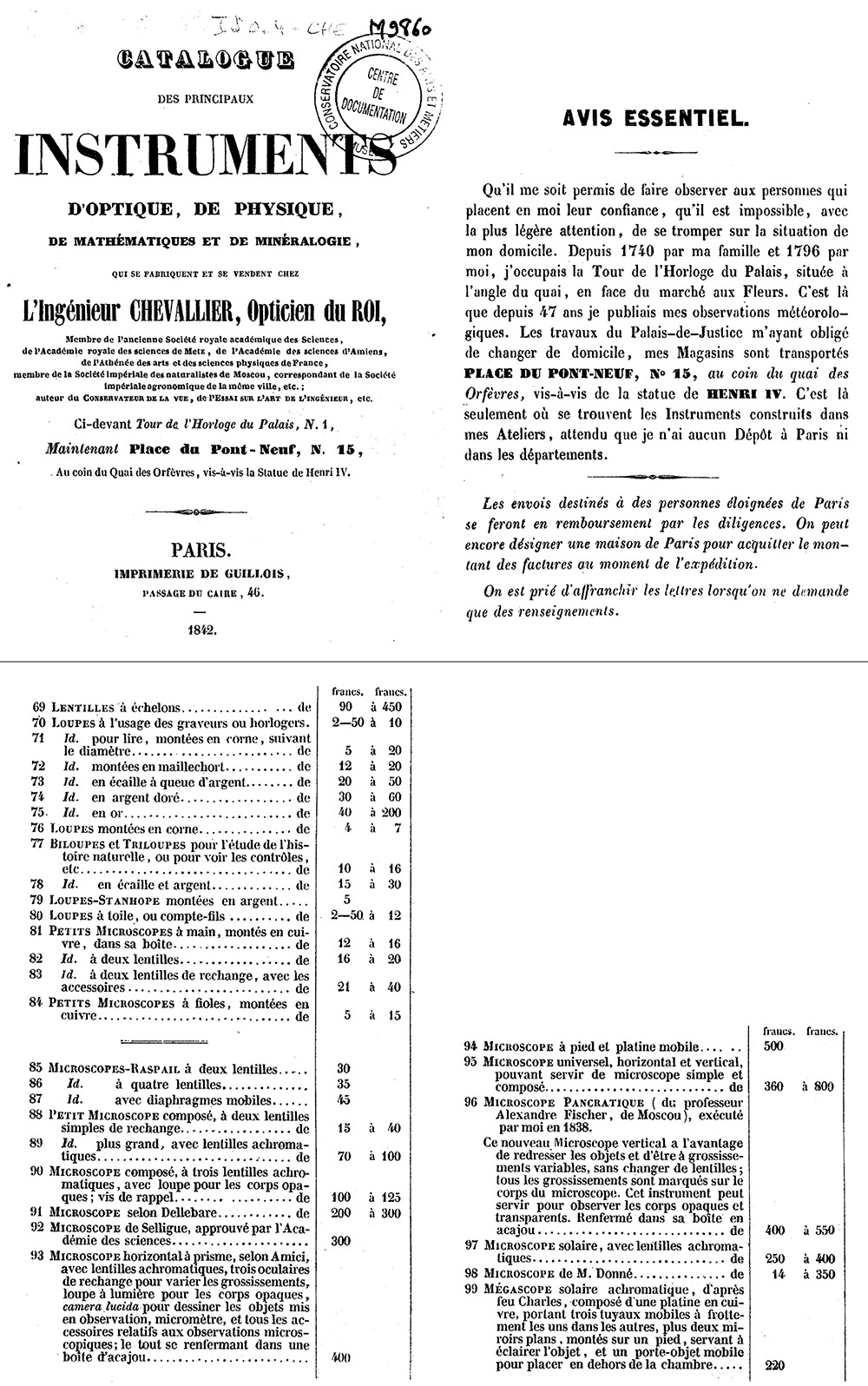
Figure 17.
Chevallier moved to 15 Place du Pont-Neuf in 1842. Excerpts from that year’s catalogue are illustrated (the title page has been condensed). A foreword states that the move was due to construction on the old building. A range of microscopes was offered, including Selligue-type, Dellebarre-type, Raspail-type, horizontal Amici-type, “pancratic”, solar projection, and simple microscopes, and an array of magnifiers.
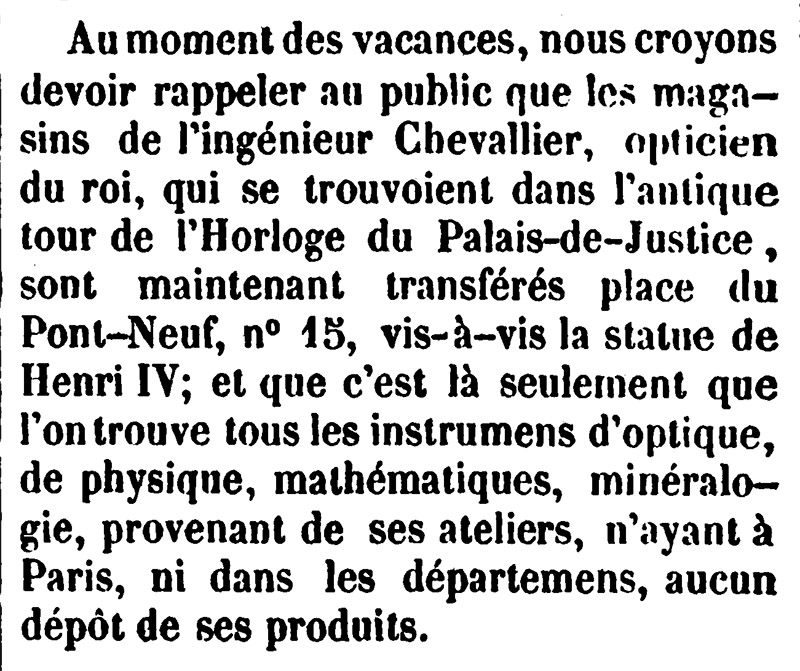
Figure 18.
March, 1843 reminder that Chevallier had moved to Place du Pont-Neuf.
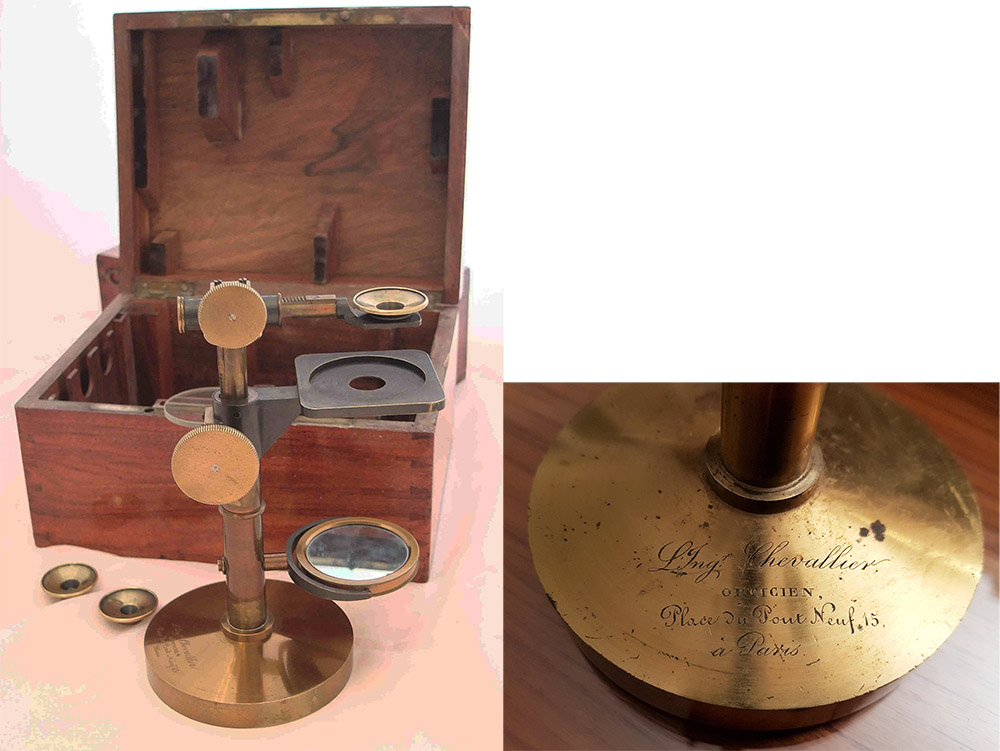
Figure 19.
A simple microscope, engraved “L’Ingr Chevallier, Opticien, Place du Pont Neuf 15, a Paris”. That name was used even though Ducray was operating the business. The inscription implies production between the time of the move to that shop (1842) and the death of J.G.A. Chevallier and renaming of the business as “Maison de L’Ingéneur Chevallier (1848). Images adapted with permission of Alexandre Piffault.
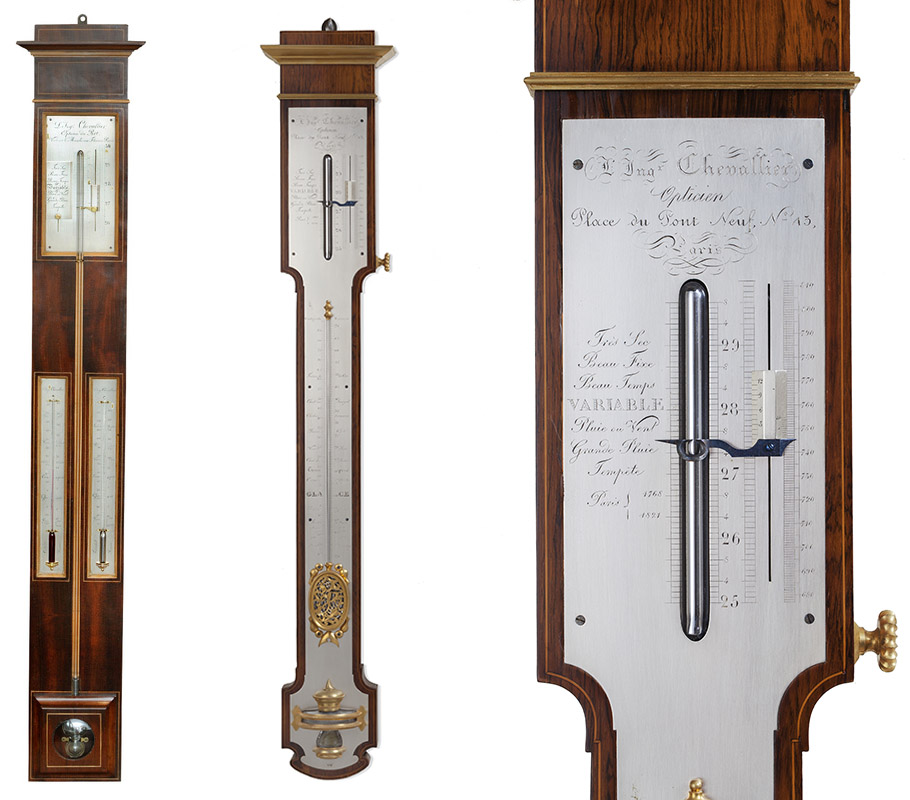
Figure 20.
Two barometers by Chavallier, both signed with the Place du Pont-Neuf address. Adapted for nonprofit, educational purposes from internet auction sites.
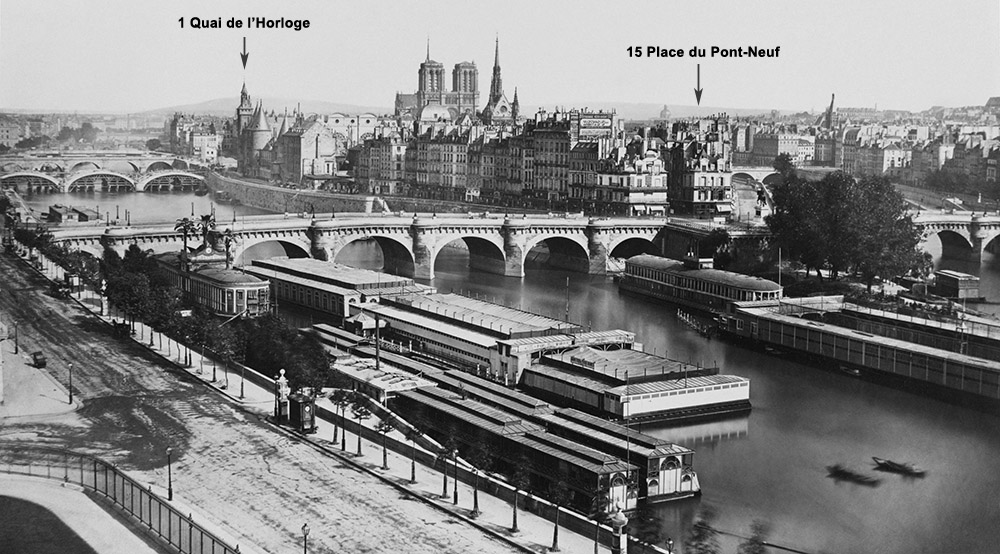
Figure 21A.
1858/1860 photograph by Edouard Baldus, from the north side of the Seine River, showing the Pont Neuf Bridge and Quai de l’Horloge. Chevallier’s original shop was in the tower at 1 Quai de l’Horloge. His second shop was along the Pont Neuf Bridge, in the building on the right side.
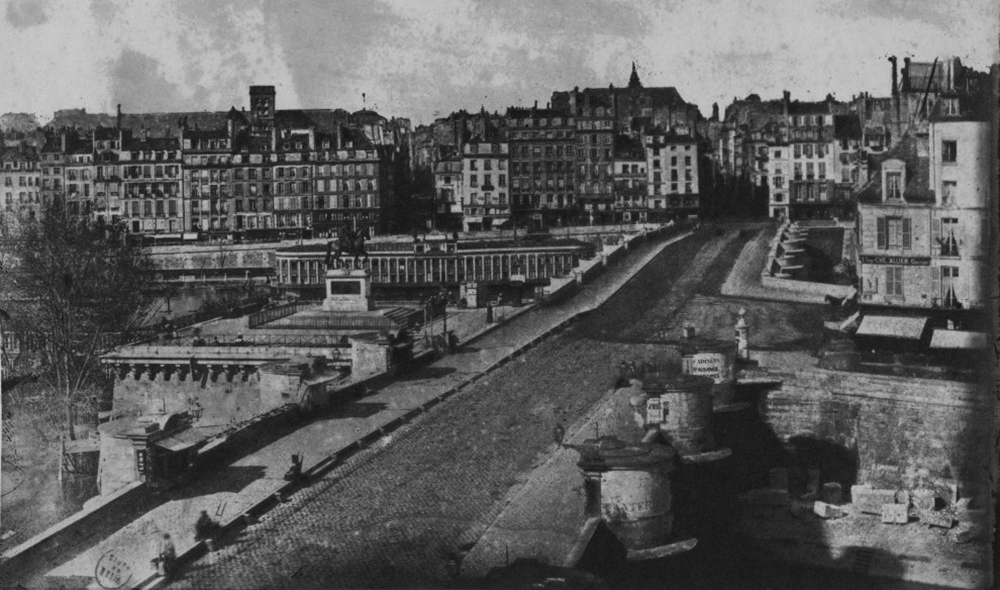
Figure 21B.
Ca. 1840s photograph of Pont Neuf, showing the Chevallier shop on the far right. It is directly opposite the equestrian statue of King Henry IV.
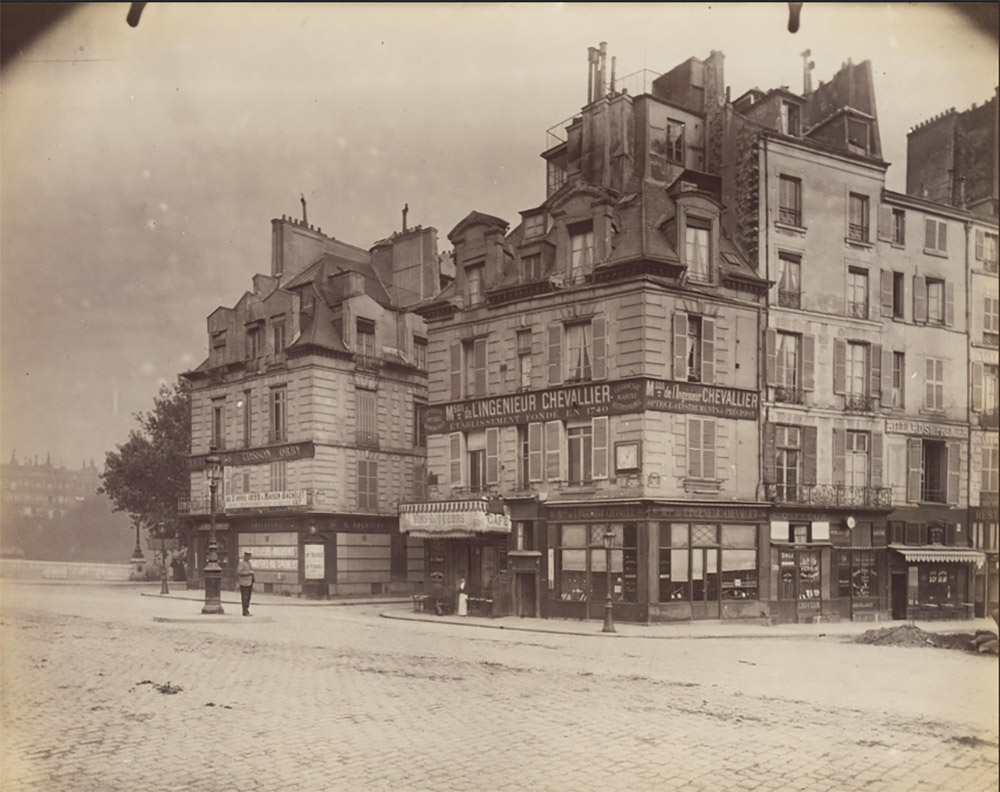
Figure 22.
A ca. 1906 view of Maison de l’Ingéneur Chevallier, 15 Place du Pont-Neuf (on the right), by Eugène Atget (1857-1927). The competing opticians shop of Lerebours and Secrétan is on the left, at 13 Place du Pont-Neuf.
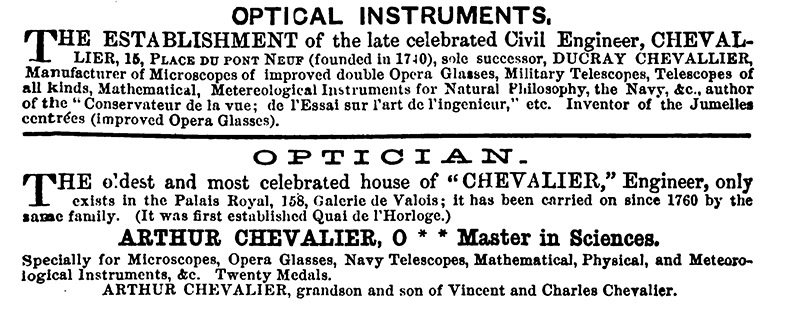
Figure 23.
1855 advertisements from Victor Ducray-Chevallier and Arthur Chevalier, from “Bradshaw's Illustrated Travellers' Hand Book to France”. Although the house of Chevallier had been continually operated within the family since its founding by François Trochon in 1740, Arthur Chevalier’s claim for the oldest house is acurate if one pays attention to spelling.

Figure 24.
An 1862 advertisement from Ducray-Chevallier, warning customers of a “house assuming a similar name”. The ”more modern” comment refers to the “recent” founding of the Chevalier house in 1760.
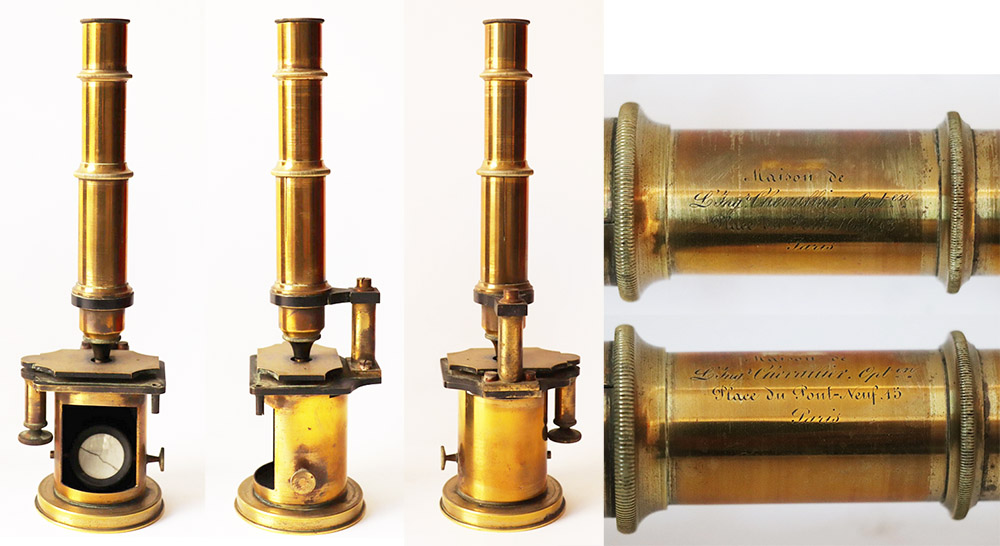
Figure 25A.
A drum-type compound microscope, signed "Maison de L’Ingr Chevallier Optn, Place de Pont Neuf 15, Paris", thus dating it from after J.G.A. Chevallier's 1848 death. This instrument appears to be identical to microscopes that were manufactured ca. 1844-1850 by Camille Nachet (1799-1881), and so was likely made by him for the wholesale market, and engraved by Ducray-Chevallier for retail. Adapted for nonprofit, educational purposes from an internet auction site.
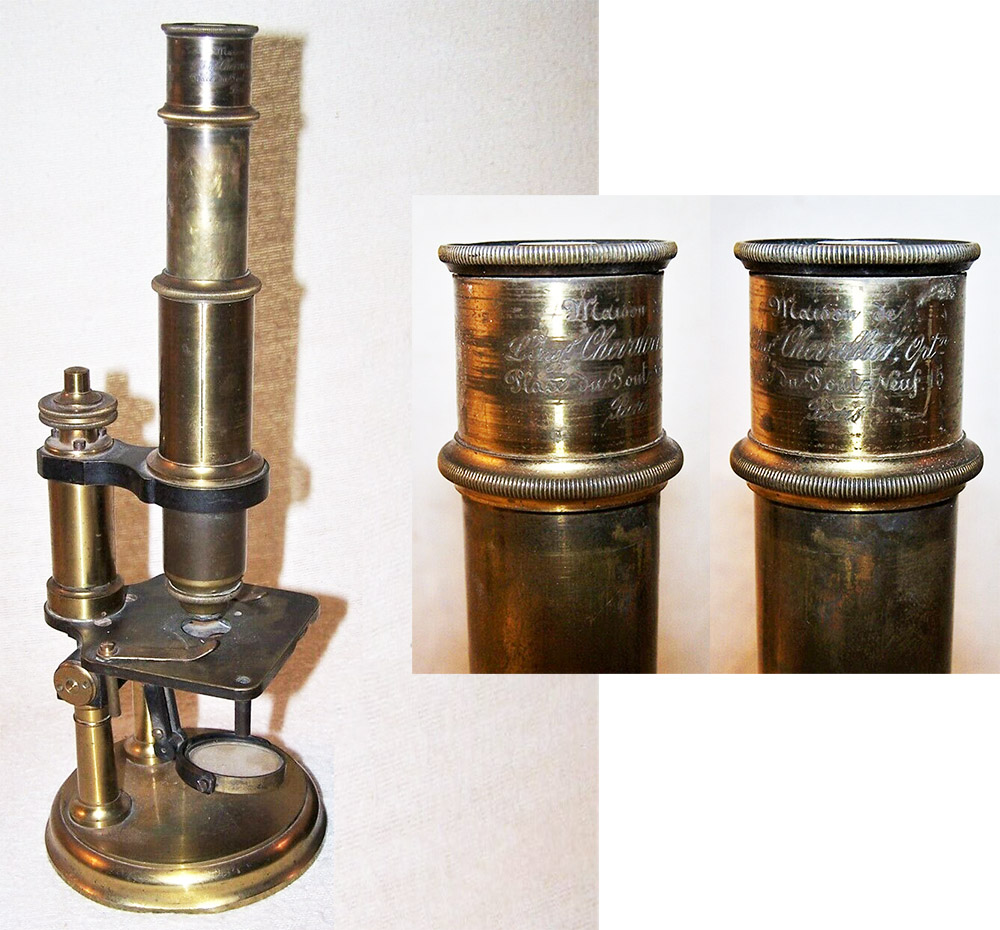
Figure 25B.
A compound microscope that is signed "Maison de L’Ingr Chevallier Optn, Place de Pont Neuf 15, Paris". It is identical to the “Microscope de Laboratoire” that was manufactured from the mid-1860s through the end of the century by Constant Verick (1829-1892) and his successor, Maurice Stiassnie (1851-1930). It was undoubtedly acquired by Ducray-Chevallier (or a successor) from Verick or Stiassnie, then engraved with "Maison de L’Ingr Chevallier" for retail. Adapted for nonprofit, educational purposes from an internet auction site.
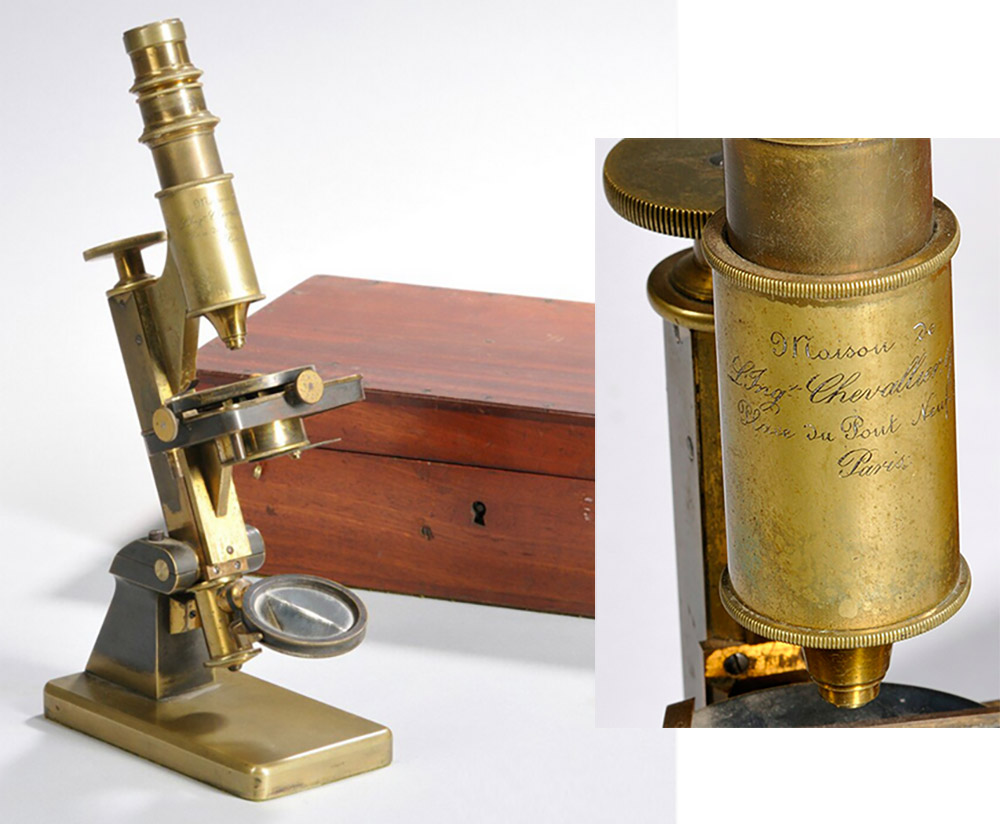
Figure 26.
A compound microscope from Maison L’Ingéneur Chevallier. Adapted for nonprofit, educational purposes from an internet auction site. Another copy of the same model is shown as Figure 158 of the “Catalogue of the Billings Microscope Collection”, Second Edition (page 84).
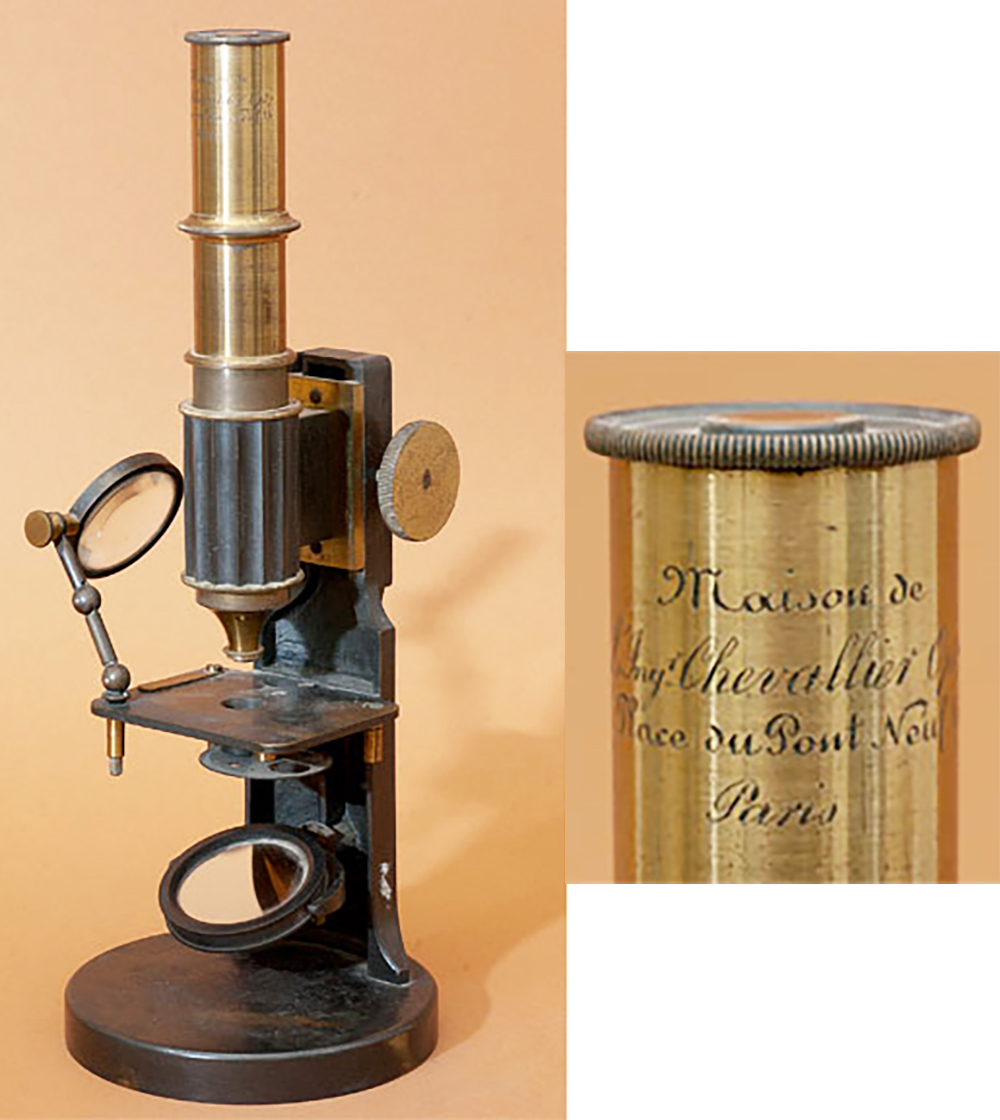
Figure 27.
Compound microscope from Maison L’Ingéneur Chevallier. Adapted for nonprofit, educational purposes from http://golubcollection.berkeley.edu/19th/266.html.
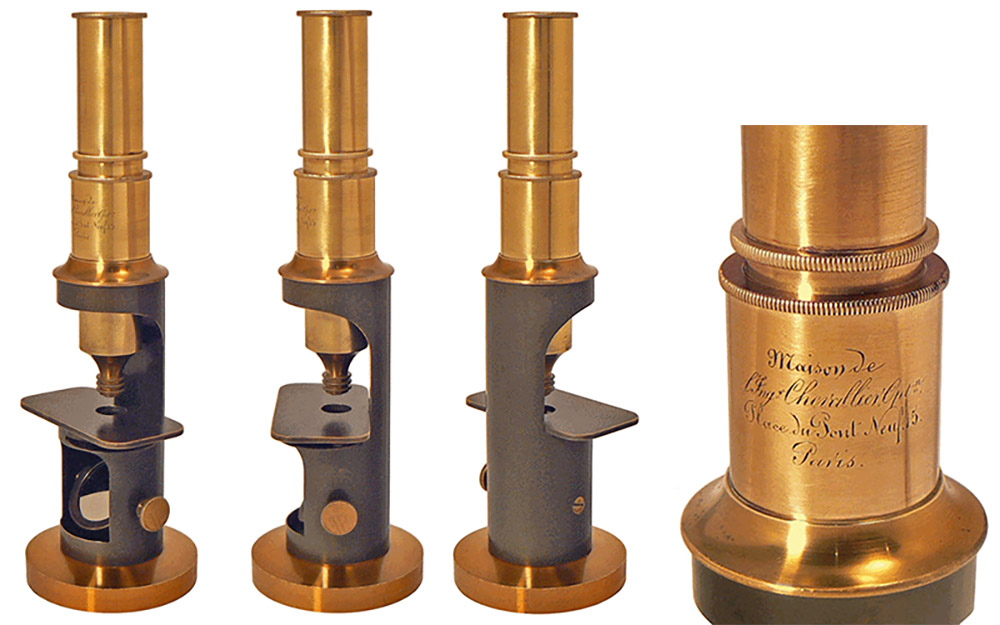
Figure 28.
Drum-style compound microscope from Maison de l’Ingéneur Chevallier. Adapted with permission from http://www.lecompendium.com/dossier_optique_196_microscope_a_niche_maison_chevallier/microscope_a_niche_ingr_chevallier.htm.
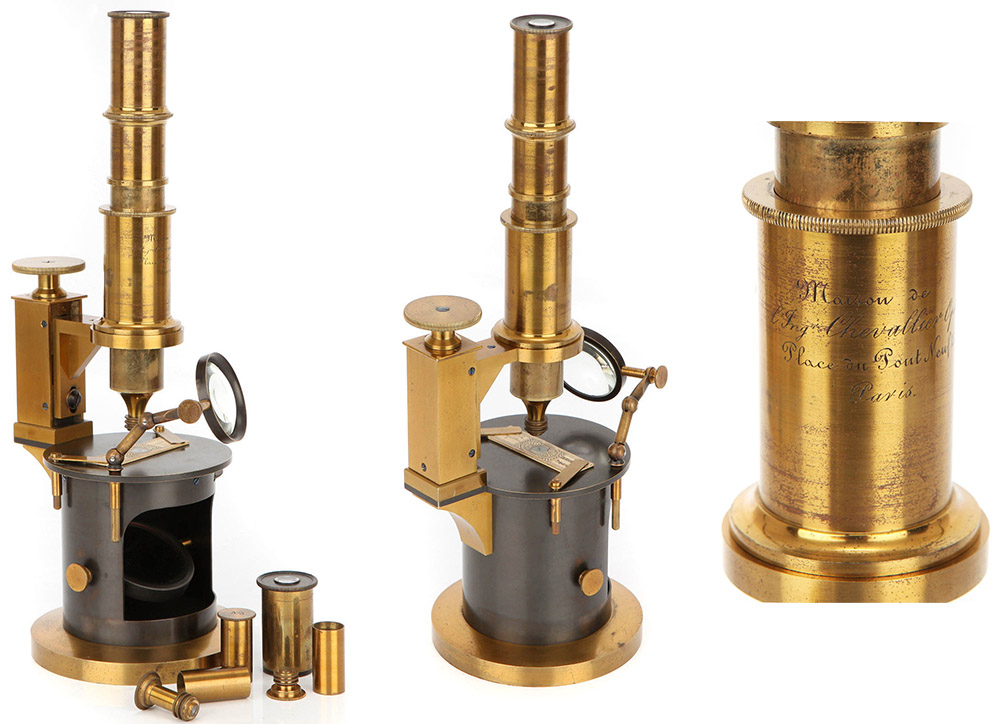
Figure 29.
A more complex Maison de l’Ingéneur Chevallier drum compound microscope, with fine focus. Adapted for nonprofit, educational purposes from an internet auction site.

Figure 30.
Solar microscope by Maison de l’Ingéneur Chevallier. Adapted for nonprofit, educational purposes from an internet auction site.
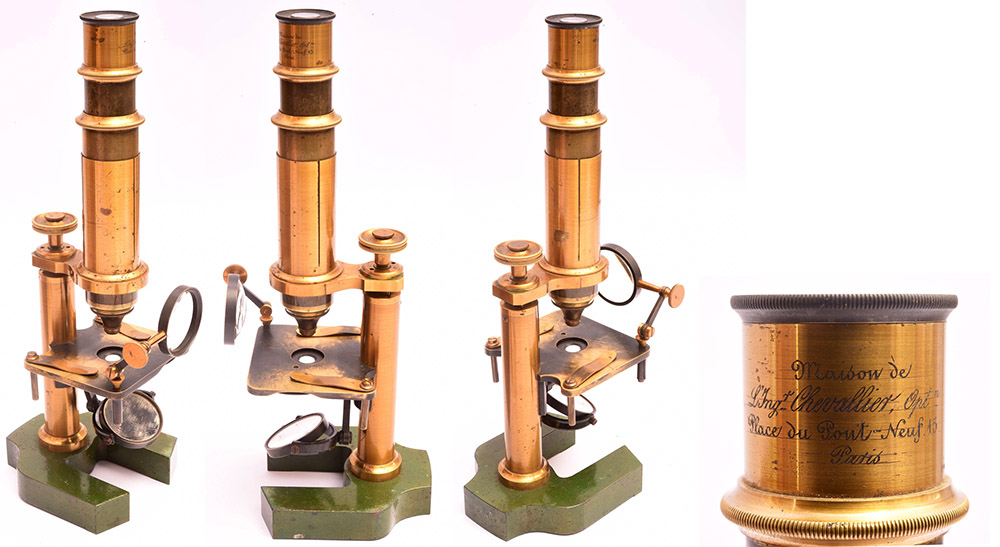
Figure 31.
Maison de l’Ingéneur Chevallier compound microscope. Adapted for nonprofit, educational purposes from an internet auction site.
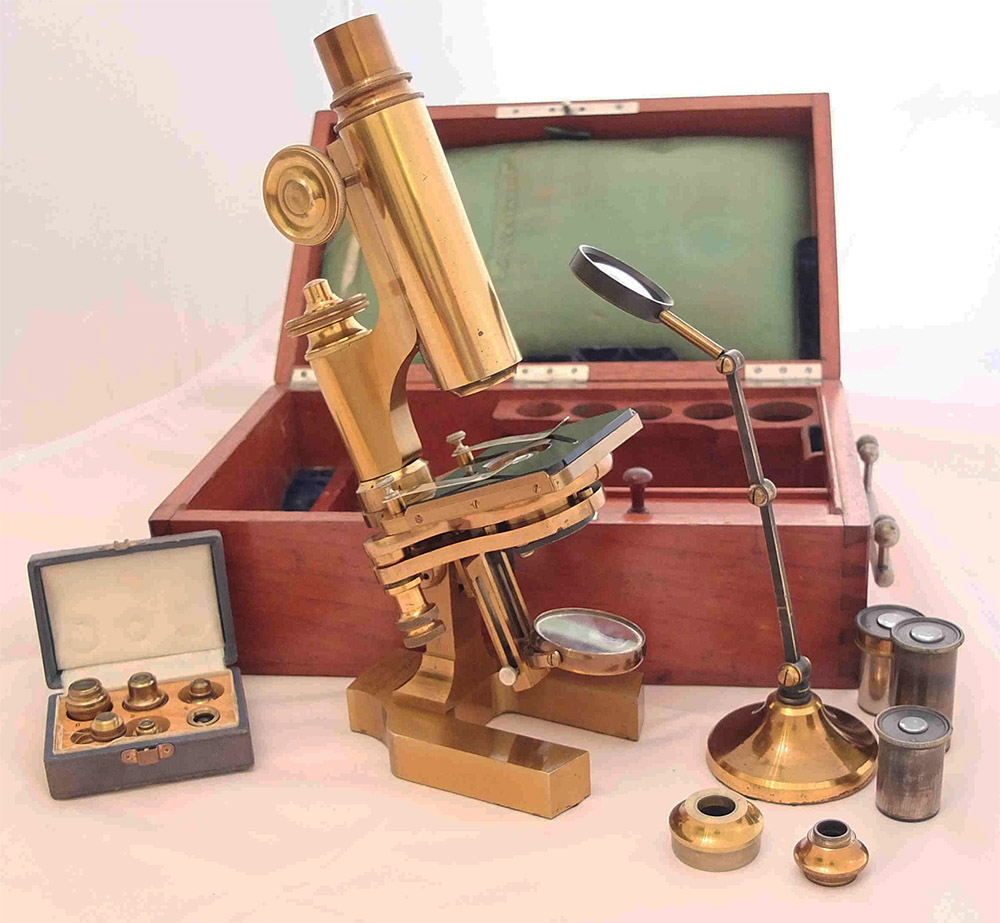
Figure 32.
Compound microscope with a “Continental” foot, from Maison de l’Ingéneur Chevallier. Adapted with permission from Alexandre Piffault.
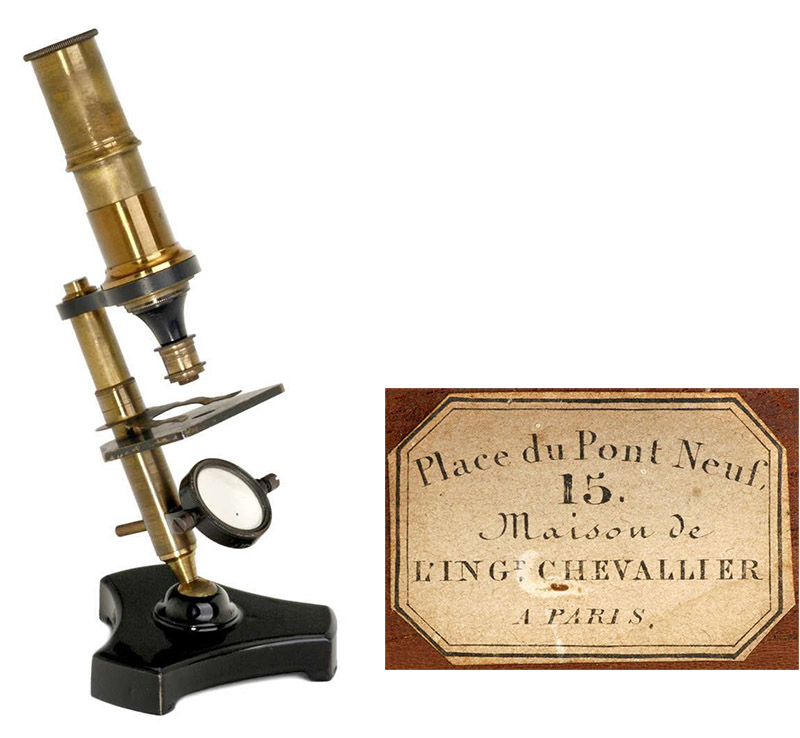
Figure 33.
Compound microscope with a Maison de l’Ingéneur Chevallier label inside its cabinet. The style suggests that it was made during the late 1800s, possibly after Mme. Ducray-Chevallier sold the business. Adapted for nonprofit, educational purposes from an internet auction site.

Figure 34.
Painted ceramic-coated opera binoculars, signed Ducray-Chevallier. It is likely that the decorations were produced by Ducray-Chevallier’s son-in-law, François Abel Catherine dit Lefèvre, who was described as a "peintre sur porcelaines" in Ducray-Chevallier’s probate record. Images courtesy of Alexander Medvedev.
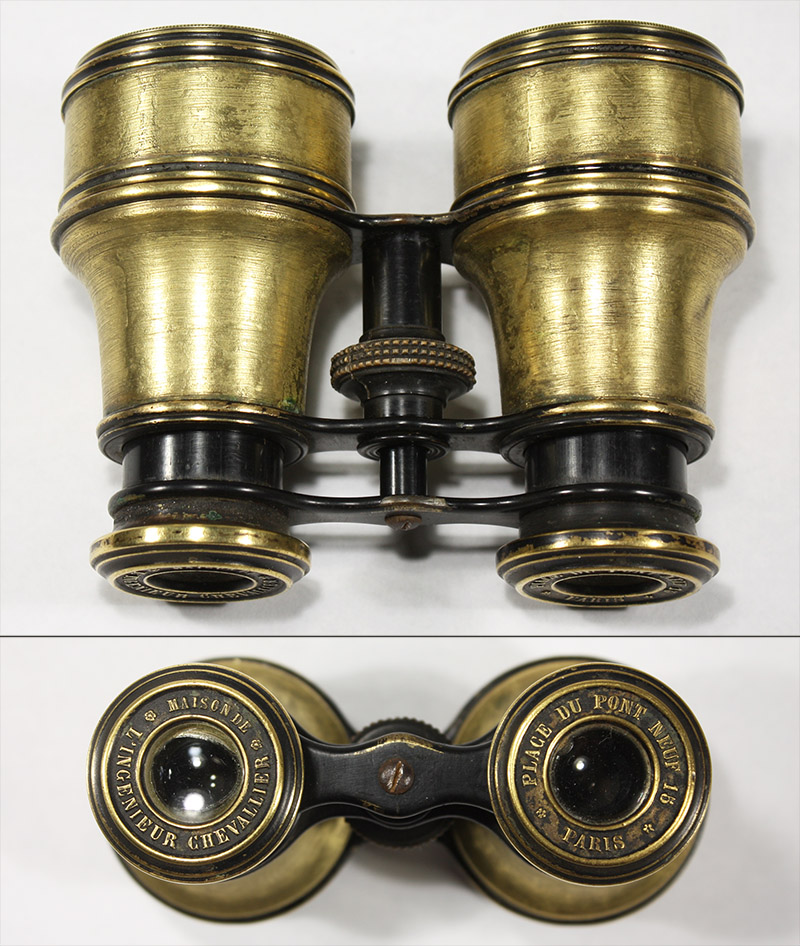
Figure 35.
Jumelles opera glasses, by Maison de l’Ingéneur Chevallier, Place du Pont-Neuf 15. The address dates them between 1848 and 1900, probably toward the late 1800s.

Figure 36.
Excerpt from the 1891 Annuaire-Almanach du Commerce, de l'Industrie, de la Magistrature et de l'Administration, showing listings for Dr. A. Chevalier and l’Ingéneur Chevallier, both of which were owned by the Avizard brothers. The list also shows information on the business formerly owned by J.G.A. Chevallier’s son, P.M.A. Chevallier, which was at that time owned by Adélaïde Queslin, as well as two minor opticians surnamed “Chevalier”.
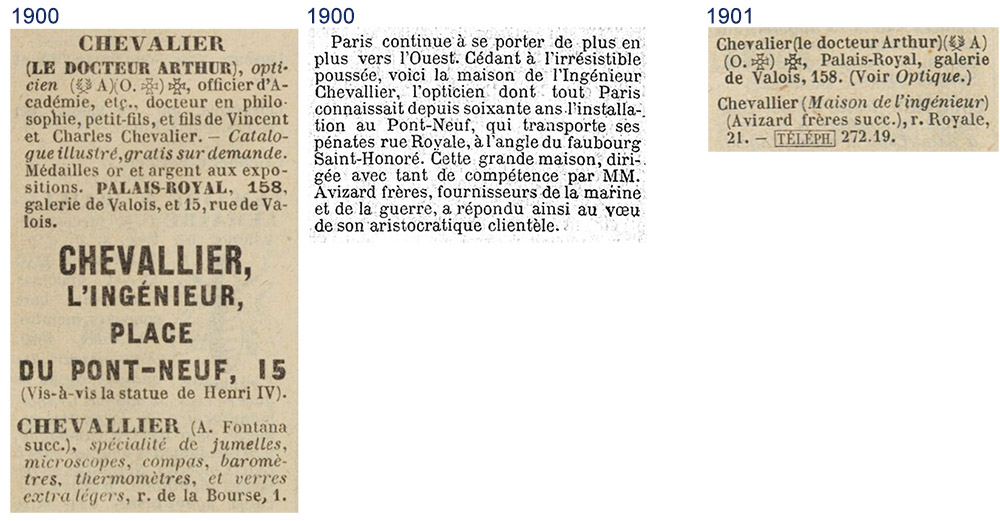
Figure 37.
The Avizards merged their shops in June, 1900, retaining the name “Maison de l’Ingéneur Chevallier”, but moving to 12 Rue Royale. Left, an excerpt from the 1900 Annuaire-Almanach du Commerce, de l'Industrie, de la Magistrature et de l'Administration, showing listings for Dr. A. Chevalier and l’Ingéneur Chevallier. Center, a notice that was published in “Le Figaro” on June 12, 1900. Right, excerpt from the 1901 Annuaire-Almanach du Commerce, de l'Industrie, de la Magistrature et de l'Administration.

Figure 38.
A pair of opera glasses, by Maison de l’Ingéneur Chevallier, Avizard Fréres, successeurs. The address printed on the case, 21 Rue Royale, dates this to between 1900 and ca. 1915. Adapted for nonprofit, educational purposes from an internet auction site.
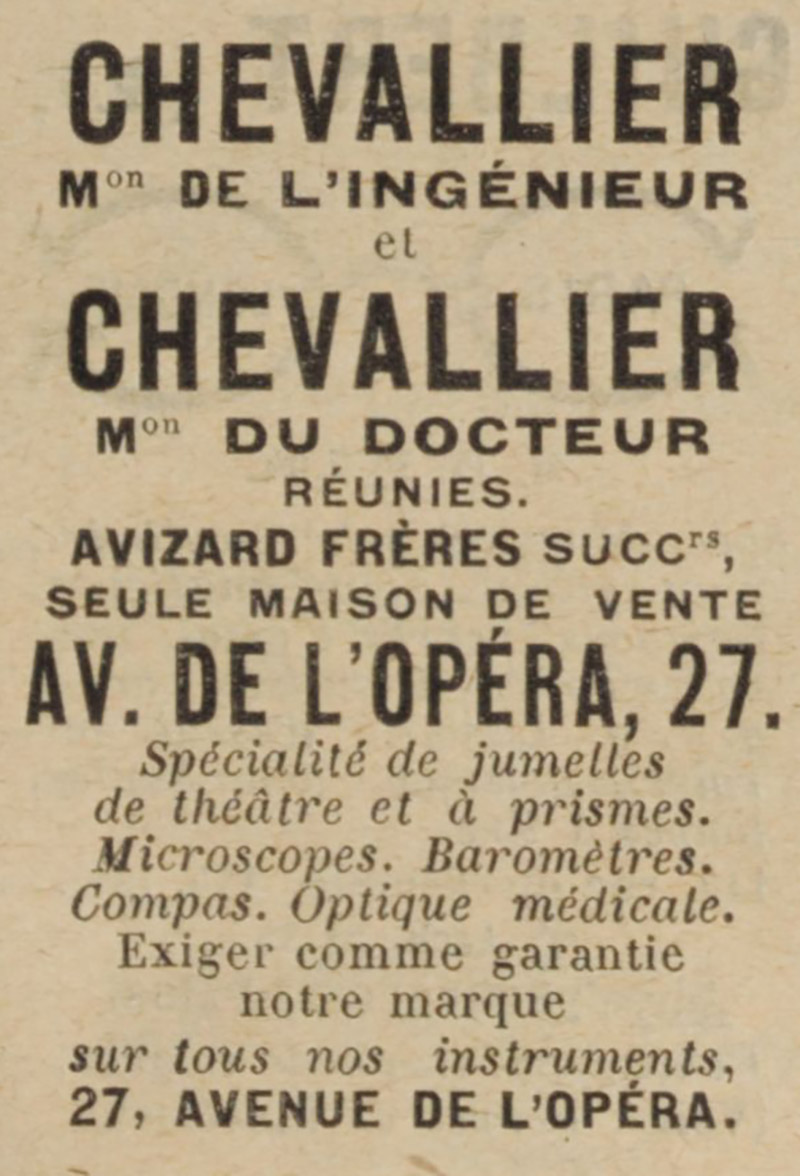
Figure 39.
Listing from the 1922 Annuaire-Almanach du Commerce, de l'Industrie, de la Magistrature et de l'Administration. Maison de l’Ingéneur Chevallier moved to 27 Avenue de l’Opera between 1907 and 1910. By 1922, the shop had been merged with the business formerly owned by Vincent, Charles, and Arthur Chevalier (Arthur was known as Dr. Chevalier, and Chevalier instruments were often signed as such after he had died).
Acknowledgements
Thank you to Joe Zeligs for many fruitful discussions, to Alexandre Piffault, Alexander Medvedev, Jean Paul Mirrione, and Albert Balasse for permission to use images, and to William Tobin for insights on the 1899 photograph of the Maison de l’Ingéneur Chevallier shop.
Resources
Almanach des 25000 Addresses des Principaux Habitans de Paris (1846) “Chevallier (le chev.), ingén. optic. du Roi, membre de plusieurs académies franc. et étrang., - place du Pont-Neuf. 15”, page 123
Almanach du Commerce de Paris, des Départemens de l'Empire (1809) Opticiens et Lunetiers, page 240
Almanach du Commerce de Paris, des Départemens de la France (1820) pages 66 and 432
Almanach du Commerce de Paris (1883) pages 1495-1497
Almanach du Commerce de Paris (1885) page 1589
Almanach du Commerce de Paris (1891) page 1795
Almanach du Commerce de Paris (1898) page 2015
Almanach du Commerce de Paris (1900) page 2111
Almanach du Commerce de Paris (1901) page 1989
Almanach du Commerce de Paris (1907) pages 2334-2335
Annuaire du Commerce de Paris (1914) page 99
Annuaire du Commerce de Paris (1921) page 788
Annuaire du Commerce de Paris (1922) page 2975
L'Ami de la Religion et du Roi (1843) Announcement of the move of Chevallier to 15 Place Pont-Neuf, March issue, page 400
“An Englishman Abroad” (1868) Recommendation of Maison de l”Ingéneur Chevallier, Practical General Continental Guide, part 1, page 9
Annales d'Oculistique (1843) Price list of l’Ingéneur Chevallier, Vol. 9, pages 103-104
Association Française Compte Rendu (1888) “Norbert-Nanta, 15, place du Pont-Neuf - Paris”, Vol. 17, Part 1, page 92
Astronomie (1907) Members: “1888 Nanta, ingénieur opticien, 60, quai des Orfèvres, Paris”, page 620
La Belgique Judiciaire (1857) Report of Ducray-Chevallier vs. Chevalier, September 15 issue, pages 767-768
J.A. Berly's Universal Electrical Directory and Advertiser (1884) “Nanta, Norbert, Opticien, 15, Place du Pont-Neuf, á Paris”, page 37
The Billings Microscope Collection, Second Edition (1974) Edited by J.L. Hansen, W.A. Schrader, W.R. Cowan, J.E. Henderson, O.W. Richards, H.R. Purtle, and J.A. Ely, Armed Forces Institute of Pathology, Washington, DC, pages 84-85, figure 158
Blancheton, Ernest (1843) Chevallier, Revue Générale, Biographique, Politique et Litteraire, Vol. 5, page 44
Bourgeois - l’Ingéneur Chevallier, opticien (web site accessed May, 2018) http://www.ingenieurchevallier.fr/file/Bienvenue.html
Bradshaw, George (1855) Advertisements from Chevallier and Chevalier, in Bradshaw's Illustrated Travellers' Hand Book to France
Bradshaw, George (1861) Advertisement from Ducray-Chevallier, in Bradshaw's Monthly Continental Railway, Steam Transit, and General Guide for Travelers to Europe, page 539
Bulletin de la Société Astronomique de France (1888) Members: “Nanta, ingénieur opticien, 15, place du Pont-Neuf, Paris”, Vol. 2, page 15
Bulletin de la Société d'Encouragement pour l'Industrie Nationale (1842) New members: “Ducray Chvallier, ingénieur-opticien, place du Pont-Neuf, 15”, Vol. 41
Bulletin des lois de la République Française (1850) Records of the September 15, 1848, Ducray-Chevallier name changes, Vol. 4, page 310
Catalogue et Prix des Instruments d'Optique, de Physique, de Mathématiques et de Minéralogie qui se Fabriquent et se Vendent Chez l'Ingénieur Chevallier, Opticien du Roi (1842)
Catalogue des Instruments d'Optique, de Physique, de Mathématiques, d’Astronomie et de Marine qui se Trouvent et se Fabriquent dans les Magasins et Ateliers de la Maison l'Ingénieur Chevallier, Opticien du Roi (1845)
Chevallier, J.G.A. (1805) Instruction sur l'Usage des Cadrans Solaires Horizontaux et Universels
Chevallier, J.G.A. (1807) Instruction sur le Microscope Construit d'Après les Principes de feu Dellebarre, par J.G.A. Chevallier, Ingénieur-Opticien, Membre de la Société Académiques des Sciences, etc.
Chevallier, J.G.A. (1810) Le Conservateur de la Vue
Chevallier, J.G.A. (1815) Le Conservateur de la Vue
Chevallier, J.G.A. (1819) Art de l’Ingénieur en Instrumens de Physique Expérimentale en Verre
Chevallier, J.G.A. (1820) Discours Prononcé par l'Ingénieur Chevallier (le Cher), Président de la Société Maconnique des Admirateurs de l’Univers, le 8 Mars 1820, à la Cérémonie Funèbre qui eut Lieu en Mémoire de S.A.R. Monseigneur le Duc de Berri, Fils de France
Chevallier, J.G.A. (1846) Historie de la Gaité
Exposition Universelle Internationale de 1878 a Paris, Catalogue Officiel (1878) Vol. 2
Le Figaro (1900) Note on move of Maison de l’Ingénieur Chevallier, June 12, page 1
Fischer, Alexandre (1841) Le Microscope Pancratique, Auguste Semen, Moscow
Foucaud, Eduard (1841) Les Artisans Illustres, Paris, pages 442-450
Foucaud, Eduard (1847) The Book of Illustrious Mechanics of Europe and America, translated by John Frost, D. Appleton & Co., New York, pages 238-242
French marriage, voter records, and other documents, accessed through ancestry.com
French notary’s reports and other legal documents, accessed through http://www.siv.archives-nationales.culture.gouv.fr
Galignani's New Paris Guide (1827) Optician – Chevallier, page lxxviii
Galignani's New Paris Guide (1839) Optician – Chevallier, page 345
Galignani's New Paris Guide (1845) Optician – Chevallier, page 503
Notary’s report of the estate of Pierre Marcel Augustin Chevallier (1841) “Inventaire après décès de Pierre Marcel Augustin Chevallier, dressé dans une maison située 1, rue de la Bourse, où le défunt est mort, le 10 novembre 1841, à la requête de sa veuve, Marie Rose Mathilde Albert, demeurant même adresse, tutrice de leurs deux filles, Mathilde Mélanie Augustine et Marie Caroline Chevallier, en présence de leur grand-père, subrogé tuteur, Jean Gabriel Augustin Chevallier, ingénieur opticien, demeurant 1, quai de l'Horloge. (2 f.). À signaler: l'acte détaille la boutique d'optique du défunt (prisée de 30e à 184e)”.
Notary’s report of the estate of Thérèse Mélanie Cotel Chevallier (wife of J.G.A. Chevallier) (1841) “Inventaire après décès de Thérèse Mélanie Cotel, dressé dans une maison située 1, quai de l'Horloge, elle-même décédée au Havre (Seine-Maritime), le 30 septembre 1841, à la requête de son mari, Jean Gabriel Augustin Chevallier, ingénieur opticien, demeurant même adresse, et de leurs cinq enfants, Pierre Marcel Augustin Chevallier, ingénieur opticien, demeurant 1, rue de la Bourse, Charles Victorin Réaumur Chevallier, ingénieur des ponts-et-chaussées, demeurant au Havre, Jeanne Victorine Mélanie Chevallier, épouse de Michel Duval, employé, demeurant 76, rue du Faubourg-Saint-Denis, Marie Louise Mélanie Chevallier, épouse d'Alexandre Victor Ducray, commis opticien chez son beau-père, demeurant 5, place du Palais [de Justice], et Eugénie Augustine Chevallier, employé, demeurant avec son père. (2 f.). À signaler : les requérants déclarent choisir de s'abstenir des formes judiciaires”.
Notary’s report of transaction between J.G.A. Chevallier, A.V. Ducray, and M.L.M. Chevallier (1842) “Obligation par Alexandre Victor Ducray, ingénieur opticien, et Marie Louise Mélanie Chevallier, son épouse, demeurant 1, quai de l'Horloge, au profit de Jean Gabriel Augustin Chevallier, ancien ingénieur opticien du roi et de l'Académie royale des sciences de Metz, demeurant 1, quai de l'Horloge Tour de l'Horloge du Palais, pour prêt d'une somme principale de 25 000 francs, remboursable par moitié les 1er janvier 1845 et 1846, accompagné d'un taux de 5 % l'an, payable par trimestre. Les contractants hypothèquent, pour sûreté de garantie, une maison située 76, rue du Faubourg-Saint-Denis”.
Notary’s report of the estate of Alexandre Victor Ducray-Chevallier (1879) “Inventaire après décès d'Alexandre Victor Ducray-Chevallier, dressé dans une maison située 15, place du Pont-Neuf, où le défunt est mort, le 11 décembre 1879, à la requête de sa veuve, Marie Louise Mélanie Chevallier, demeurant même adresse, et de son gendre, François Abel Catherine dit Lefèvre, peintre sur porcelaines, demeurant 22, rue du Faubourg-du-Temple, tuteur de son fils, Paul Édouard Catherine dit Lefèvre, par représentation de Clémence Mélanie Ducray-Chevallier sa mère, décédée le 7 novembre 1870. (18 f.)”.
Notary’s report of the formation of the partnership of René and Charles Avizard (1880) “Création d'une société en nom collectif entre Charles Xavier et René Gabriel Avizard, tous deux fabricants d'instruments d'optique, et en commandite à l'égard de leur père, Charles Denis Adelle Avizard, demeurant 57, rue Rambuteau, ayant pour objet l'exploitation d'un fonds de commerce de fabricant d'instruments d'optique, sous la raison sociale, René et Charles Avizard, établie pour une durée de 6 ans, au capital de 125 000 francs, siège social situé 57, rue Rambuteau”.
Notary’s report of the sale of Maison de l’Ingéneur Chevallier to René and Charles Avizard (1883) “Vente par Marie Louise Mélanie Chevallier, opticien, veuve d'Alexandre Victor Ducray-Chevallier, demeurant 15, place du Pont-Neuf, à la société René et Charles Avizard, représentée par leurs fondateurs, Charles Xavier et René Gabriel Avizard, tous deux fabricants d'instruments d'optique, demeurant 57, rue Rambuteau, d'un fonds de commerce pour la fabrication et la vente d'instruments d'optique, géodésie, mathématiques, physique, lunetterie et instruments de précision, situé 15, place du Pont-Neuf et 76, quai des Orfèvres, sous la raison sociale Ancienne Maison de l'Ingénieur Chevallier, pour la somme de 102 000 francs”.
Notary’s report of the death of René and Charles Avizard father (1883) “Inventaire après décès de Charles Denis Adelle Avizard, dressé dans une maison située 4, avenue du Bois Préau à Rueil-Malmaison, où le défunt est mort, le 21 mars 1883, et dans un fonds de commerce d'optique situé 158, galerie de Valois au Palais-Royal, à la requête de sa veuve, Gabrielle Godet, demeurant même adresse, et comme tutrice de leur fils, Georges Émile Avizard, et de leurs trois autres fils, René Gabriel Avizard, fabricant d'instruments d'optique, demeurant 57, rue Rambuteau, Charles Xavier Avizard, fabricant d'instruments d'optique, demeurant 29, boulevard de Magenta, et Paul Joseph Avizard, licencié en droit, demeurant avec sa mère”.
Notice des Produits de l'Industrie Française (1834) “M. Chevallier, opticien du Roi, chevalier de la Légion-d'Honneur, membre dé l'ancienne société royale académique des Sciences, de l'académie royale des Sciences de Metz, de l'académie d'Amiens, etc.”, pages 67-68
Palaprat, Bernard-Raymond Fabré (1827) Rapports sur le Microscope Achromatique de M. Selligue, Construit par l'Ingénieur Chevallier
Querard, J.M. (1828) Chevallier (le chev. J. Gabr. Aug.), in La France Littéraire ou Dictionnaire Bibliographique, Vol. 2, Didot, Paris, page 183
Rapport sur les Produits de l'Industrie Française (1828) M Chevallier, page 382
Rouyer, Joseph (1901) Coup d'Oeil Rétrospectif sur la Lunetterie, Second edition, Rouyer, Paris, pages 212-219
Early photographs of Paris, showing Chevallier’s shop on Place de Pont-Neuf, http://vergue.com/post/313/Henri-IV-et-la-Seine












































